- Subscribe Now
- Digital Editions

Mussolini’s yacht seized from suspected mafia businessman
- Jamey Bergman
The yacht was a gift to the Fascist dictator in the 1930s.

Italian police have seized a yacht that once belonged to Italian dictator Benito Mussolini from a businessman they believe has links to organised crime. The historic sailboat, called Fiamma Nera (Black Flame), was one of nearly €30m in assets taken from Italian entrepreneur Salvatore Squillante as part of an investigation into multiple individuals and companies. Squillante, 68, allegedly purchased the yacht through one of the companies seized as part the “Mafia Capital” organised crime trials that began in Rome in November 2015. Mussolini received the Fiamma Nera as a gift in the 1930s from a fascist supporter. The dictator sank the yacht intentionally to keep it out of German hands when Italy fell to the Nazis during World War II in 1943. Fiamma Nera , originally named Konigin II, was eventually recovered, then restored and renamed Serenella. The vessel went through several owners and various name changes before allegedly being purchased through one of Squillante’s companies seized by Italian police. In addition to the classic sailboat, Italian media reported the businessman’s seized assets included a castle, apartments, luxury cars, offices and stores in Rome. A court document that revealed the identity of the businessman reportedly suggested that he may have links to a Rome-based mafia network allegedly run by a former neo-fascist mobster. The investigation into the network is focused primarily on the use of public funds in allegedly illegal or fraudulent activities. Fiamma Nera is said to be a Dutch yawl built by German shipyard Abeking and Rasmussen in 1912. Related links: Luxury yacht linked to Churchill and WWII battle on sale for €2m WWII U-boat defences to bring broadband to Orkney Islands

Pictures: WWII concentration camp to become luxury resort with yacht marina
The Montenegrin government agreed to allow a Swiss-Egyptian development group to turn what was once a WWII concentration camp into…

Divers in Indonesia discover WWII U-boat in the Java Sea
Team of researchers followed tip-off from local divers to uncover hidden World War II U-boat with its crew still aboard

WWI U-boat missing for 100 years discovered off Norfolk coast
Windfarm developers ScottishPower Renewables have identified an uncharted wreck off the Norfolk coast as a German WWI U-boat missing in…
- The Magazine
- Stay Curious
- The Sciences
- Environment
- Planet Earth
Nemi Ships: How Caligula's Floating Pleasure Palaces Were Found and Lost Again
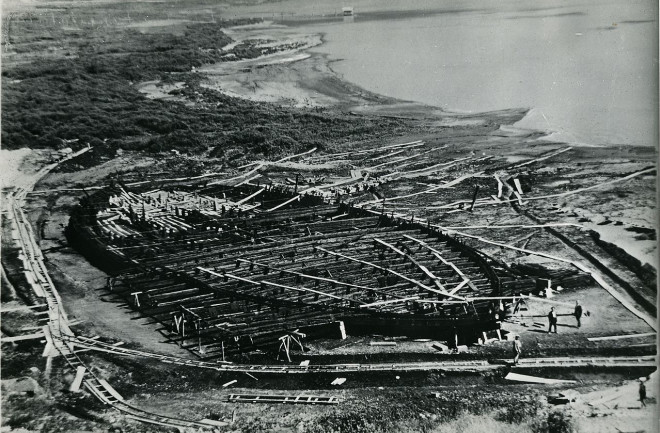
For centuries, the medieval fishermen who sailed in the placid waters of Lake Nemi, 19 miles south of Rome, knew a secret. It was said that the rotting timbers of a gigantic ancient shipwreck lurked below the water’s quiet surface. But the lake was tiny, with an area of only 0.6 square miles. And with no other body of water connected to it, what could a vessel of that size be doing there? Still, the stories about the gigantic ship persisted.
They couldn’t have known then, but at the bottom of this tiny lake were two of the most unique artifacts ever to be uncovered from the ancient world. Their story would span millennia, bridging the eccentricities of Rome’s most notorious Emperor and one of the twentieth century’s most reviled rulers — only to be lost forever in the fires of war.
Leviathans in the Deep
Looking at the placid waters of Lake Nemi in the 15th century, none of that would have seemed plausible. But for years now, fishermen had been using grappling hooks to bring up ancient artifacts from the legendary wreck that lay beneath, and selling them in the markets. An investigation was warranted.
In 1446, a young Cardinal and nephew of the Pope named Prospero Colonna, decided to probe for himself the rumours of an unlikely shipwreck at the bottom of Lake Nemi. He sailed out onto the lake, and sure enough, he could just make out a sprawling lattice of wooden beams. He and his men tried to send down ropes with hooks on the end to retrieve parts of this mysterious structure, but at a depth of 60 feet they didn’t have much luck. All they managed was to tear off some planks. Colonna had confirmed that the wreck existed, but from there the mystery only deepened.
Lake Nemi today. (Credit: Wikimedia Commons)
In 1535, Italian inventor Guglielmo de Lorena and his partner Francesco de Marchi returned to the wrecks with a new and exciting technology: a diving bell. They descended through the murk and gloom and saw an enormous wooden superstructure far vaster than anything they had imagined. The two fished around in the lake bottom for artifacts, and managed to bring up sculptures made of marble and bronze scattered on the muddy lake bottom. Many others tried to explore and survey the wrecks, but without much success. It wasn’t until Italy fell under the sway of the fascist dictator Benito Mussolini that the ships would finally be uncovered.
A Dictator Obsessed
Mussolini was a man obsessed with the legacy of Imperial Rome, and he worked hard to include its archaeological remains in his cult of personality. Mussolini had embarked on ambitious projects around the capita:, Excavating the mausoleum of Augustus to build a Fascist piazza around it, clearing the buildings that clustered around the Theatre of Marcellus and digging up the floor of the Colosseum’s Arena to expose the hypogeum beneath and stripping it of its once verdant plant life. He was frequently described in propaganda dispatches as “a new Augustus”, evoking the Roman Emperor who rebuilt much of the city during his reign.
It was only a matter of time, then, before the dictator’s attention turned to the mysterious ships at the bottom of Lake Nemi. In 1929, Mussolini ordered something unprecedented. The whole of Lake Nemi would be drained. Engineers reactivated an ancient Roman cistern that together with a modern pump reduced the lake’s water level by 65 feet. In the mud, slowly emerging from the waters, the Italian engineers found not one, but two enormous shipwrecks. The excavations would take years, with the second ship not brought up until 1932.
The ships were vast, among the largest ever recovered from the ancient world. The largest was 240 feet in length, the same length as an Airbus A380, and measured 79 feet across. From inscriptions on lead pipes and tiles, it soon became clear that what had been discovered were the floating pleasure palaces of the infamous first century Roman Emperor Caligula.
The larger of the two Nemi pleasure palaces. (Credit: Wikimedia Commons)
From One Emperor to Another
Caligula was Emperor for only four years, from 37-41 CE, but his name has lived on in history due to a penchant for sadism, hedonistic excess and brutality. He demanded to be worshipped as a living God, and had the expensive tastes to match. Records show that he emptied the Imperial treasury in a single year with extravagant games and spectacles.
It seems Caligula may have built his ships on the tiny Lake Nemi due to its alignment with the goddess Diana Nemorensis, a fitting place for a living divinity to site his pleasure barges. Here, Caligula had two ships built at enormous expense. The largest, dubbed the “prima nave” (first ship) was an enormous vessel, steered with oars 36 feet long. The second was a giant floating platform replete with marble palaces, gardens, and a system of plumbing for baths. Roman historian Seutonius described the sight of the ships: “Ten banks of oars… the poops of which blazed with jewels… filled with ample baths, galleries, and saloons, and supplied with a great variety of vines and fruit trees.”
On these ships, Caligula was reported to hold parties where his wild and licentious appetites ran wild, with later historians repeating scurrilous and outlandish rumours about relationships with the wives of his generals and senators, and even with his own sisters.
A man poses with one of the Nemi ships. (Credit: Archivio fotografico storico del Museo della scienza e della tecnologia L. da Vinci/Wikimedia Commons)
Until the discovery of the Nemi pleasure barges, it was thought that the Romans were incapable of building such large vessels. Historians had assumed that measurements of up to 164 feet given for grain-carrying vessels in some ancient sources were exaggerations. The Nemi ships show they may have been real. While excavating at Lake Nemi, Italian archaeologists uncovered a veritable treasure trove of artifacts from the wrecks. Vast anchors, bronze mouldings and marble statues came up from the depths, along with ornamental oar rings and joints in copper and bronze. They found carvings and mosaics, even gilded copper roof tiles that would have shone spectacularly in the sun. The expense of the vessels would have been enormous.
Bronze oar rings recovered from the pleasure barges. (Credit: Folegandros/Wikimedia Commons)
The wooden beams of the ships were even coated with lead, a costly treatment designed to protect sea-going vessels from shipworms. Here this treatment was useless, since shipworms don’t live in fresh water. Despite their expense, these opulent palaces were afloat for only the briefest time. It seems they were only in use for about a year before Caligula’s four year reign came to an end. An alliance of senators and the Praetorian Guard ambushed him in a tunnel beneath Rome’s Capitoline Hill and stabbed him to death. Attempts to restore the Republic after Caligula’s death failed. The Roman military ignored the senate and reinstated Imperial monarchy. Caligula’s floating palaces, too, went the way of their creator. Their hulls pierced, the immense ships were weighted with stones and sunk to the lake bottom.
Pride and the Fall
For Mussolini, the recovery of the ships had been a significant triumph. As the mud-soaked wrecks rose out of lake Nemi, it seemed a good metaphor for his promises to revive the legacy of ancient Rome in the modern day. He had a huge museum built in 1936 to house the wrecks, so that the public could visit. But Mussolini, like Caligula, would soon face a fitting downfall. And the Nemi ships would follow him into the ashes of history.
Mussolini at the dedication of the museum housing the Nemi ships, 1940. (Credit: Wikimedia Commons)
On the night of May 31 1944, less than four years since Mussolini entered the Second World War in support of Hitler’s Germany, Italy was on the brink of defeat. The country had nearly capitulated, and had been invaded by the Nazis to prevent their resistance from collapsing. But the Germans were on a multi-front retreat across all of Europe. Allied troops were closing in.
It’s not known whether the fires started as a result of US artillery or German arson. Nazi troops frequently set fire to positions they abandoned, blowing up bridges on the retreat and doing anything they could to slow the advance of the Allies. Either way, the Nemi ships burned. Only some bronzes survived, along with a handful of photographs of the colossal wrecks. Like Caligula, Mussolini met an ignoble end. Less than a year after the ships burned, he was shot while fleeing Italy in disguise. Two days later, Hitler followed by shooting himself.
Today, the ghosts of the Nemi ships live only in their photographs, and the few remaining artifacts that survived the fire. They form a haunting parable for those who would use the remains of the past for their own ends, while taking no heed of their warnings.
- archaeology
Already a subscriber?
Register or Log In

Keep reading for as low as $1.99!
Sign up for our weekly science updates.
Save up to 40% off the cover price when you subscribe to Discover magazine.
- International edition
- Australia edition
- Europe edition

Italian police seize Mussolini's yacht from businessman linked to mafia
Boat that was gifted to the fascist dictator in the 1930s has been confiscated from Salvatore Squillante as part of an investigation into organised crime
Italian police have seized a yacht that once belonged to fascist dictator Benito Mussolini from a businessman suspected of links to a huge organised crime network.
The yacht was among €28m ($30.5m) worth of assets including real estate, luxury cars and company stakes sequestered in an investigation into three individuals and 10 companies, the finance police said in a statement.
A confiscation order from a Rome court named the businessman as Salvatore Squillante, 68. The lawyer named in the order as acting for Squillante declined to comment. The finance police did not name the businessman.
Squillante had bought the classic sailboat, which was christened the Black Flame by a fascist friend who gave it to Mussolini as a present in the 1930s, through one of the seized companies.
The boat was deliberately sunk in 1943 to stop it falling into German hands after the fascist regime fell, and was then hauled out and restored after the war.
The court document said Squillante, who served a community service sentence for a 1993 fraudulent bankruptcy, made business deals that suggested he might be linked to a Rome-based mafia network run by a former neo-fascist gangster.
He rented property to a firm owned by convicted murderer Salvatore Buzzi, who is accused of being a prominent member of the crime ring that allegedly skimmed millions of euros off city hall contracts in Rome.
His activities “could raise suspicions of a possible hidden pact between this man and members of organised crime (groups) to share out money from contracts to manage migrant reception awarded by the (Rome) administration“, the court document said.
During the Capital Mafia investigation, police who had tapped Buzzi’s telephone recorded him saying the drug trade was less lucrative than schemes involving migrants.
- Benito Mussolini
Most viewed
Italian police say seize Mussolini's yacht from businessman linked to mafia
- Medium Text
Reporting by Isla Binnie; Editing by Mark Heinrich
Our Standards: The Thomson Reuters Trust Principles. , opens new tab

Azerbaijan proposes document on principles of peace before full deal with Armenia
Azerbaijan is proposing to sign a document with Armenia on the basic principles of a future peace treaty as an interim measure as they wrangle over a broader deal, a senior Azerbaijani official said on Sunday.

- Today's news
- Reviews and deals
- Climate change
- 2024 election
- Fall allergies
- Health news
- Mental health
- Sexual health
- Family health
- So mini ways
- Unapologetically
- Buying guides
Entertainment
- How to Watch
- My watchlist
- Stock market
- Biden economy
- Personal finance
- Stocks: most active
- Stocks: gainers
- Stocks: losers
- Trending tickers
- World indices
- US Treasury bonds
- Top mutual funds
- Highest open interest
- Highest implied volatility
- Currency converter
- Basic materials
- Communication services
- Consumer cyclical
- Consumer defensive
- Financial services
- Industrials
- Real estate
- Mutual funds
- Credit cards
- Balance transfer cards
- Cash back cards
- Rewards cards
- Travel cards
- Online checking
- High-yield savings
- Money market
- Home equity loan
- Personal loans
- Student loans
- Options pit
- Fantasy football
- Pro Pick 'Em
- College Pick 'Em
- Fantasy baseball
- Fantasy hockey
- Fantasy basketball
- Download the app
- Daily fantasy
- Scores and schedules
- GameChannel
- World Baseball Classic
- Premier League
- CONCACAF League
- Champions League
- Motorsports
- Horse racing
- Newsletters
New on Yahoo
- Privacy Dashboard
Italian police say seize Mussolini's yacht from businessman linked to mafia
ROME (Reuters) - Italian police said on Monday they had seized a yacht that once belonged to Fascist dictator Benito Mussolini from a businessman possibly linked to a huge organized crime network. The yacht was among 28 million euros ($30.5 million) worth of assets including real estate, luxury cars and company stakes sequestered in an investigation into three individuals and 10 companies, the finance police said in a statement. A confiscation order from a Rome court named the businessman as Salvatore Squillante, 68. The lawyer named in the order as acting for Squillante declined to comment. The finance police did not name the businessman. He had bought the classic sailboat, which was christened the "Black Flame" by a Fascist friend who gave it to Mussolini as a present in the 1930s, through one of the seized companies. The boat was deliberately sunk in 1943 to stop it falling into German hands after the Fascist regime fell, and was then hauled out and restored after the war. The court document said Squillante, who served a community service sentence for a 1993 fraudulent bankruptcy, made business deals that suggested he might be linked to a Rome-based mafia network run by a former neo-fascist gangster. He rented property to a firm owned by convicted murderer Salvatore Buzzi, who is accused of being a prominent member of the crime ring that allegedly skimmed millions of euros off city hall contracts in Rome. His activities "could raise suspicions of a possible hidden pact between this man and members of organized crime (groups) to share out money from contracts to manage migrant reception awarded by the (Rome) administration", the court document said. During the "Capital Mafia" investigation, police who had tapped Buzzi's telephone recorded him saying the drug trade was less lucrative than schemes involving migrants. (Reporting by Isla Binnie; Editing by Mark Heinrich)
Recommended Stories
Trump turns up heat on fed ahead of expected rate cuts: 'it's something that they know they shouldn’t be doing.'.
New comments from former President Donald Trump are turning up the political pressure on the Federal Reserve just as policy makers make it clear they are getting closer to cutting interest rates.
Former NFL wide receiver Jacoby Jones, a standout with the Texans and Ravens, dies at age 40
Jones, known for the Mile High Miracle and his two touchdowns for the Ravens in Super Bowl XLVII, died at home days after his 40th birthday.
Brandon Aiyuk's 5 most likely landing spots after his trade request
If Brandon Aiyuk is traded, who will he land with?
Rolex prices are falling and supplies are rising
For investors in Swiss watch brands, new data shows long-running price declines will continue.
WNBA All-Star Game: Arike Ogunbowale wins MVP with record 34 points as Team WNBA defeats Team USA
Arike Ogunbowale put on a show during the WNBA All-Star Game in Phoenix. She scored 34 points, all in the second half, to lead Team WNBA to a 117–109 win over Team USA.
Trump is starting to move markets
Stocks, bonds, crypto, and other assets are starting to move based on the rising odds of a second Trump term.
Why a CD should be part of your retirement savings plan
When you’re mapping out your retirement strategy, make sure it includes a certificate of deposit. A retirement CD has a lot of advantages, like guaranteed income, that can strengthen a retirement portfolio.
2024 NFL offseason power rankings countdown and season preview
Our Frank Schwab counts down his NFL power rankings, grades each team's offseason, solicits fantasy football advice and previews what the 2024 season might have in store for each team.
Jerry Rice confronts reporters at celebrity golf tournament, threatening violence against them
Hall of Fame receiver Jerry Rice had a bizarre confrontation with reporters at the American Century Championship celebrity golf tournament.
How 'Project 2025' could change Medicare
The newly prominent "Project 2025" developed by conservative allies of Donald Trump could radically alter Medicare as seniors know it — if the ideas ever come to pass.
What is the monthly payment on a $600,000 mortgage?
A $600,000 mortgage monthly payment depends on your loan term and interest rate. Read expert advice to learn whether a $600,000 mortgage is right for you.
Team USA defeats South Sudan in narrow 101-100 victory ahead of Paris 2024 Olympics
After a first half filled with poor shooting, a third-quarter comeback and a game-winning shot from LeBron James helped the U.S. hold on against South Sudan.
'EA Sports College Football 25' predicts the 2024 season
Here are 10 takeaways from the first-ever Yahoo Sports "EA Sports College Football" simulation.
Skip Bayless reportedly leaving FS1’s ‘Undisputed’ later this summer, ESPN quickly says it's not interested
Bayless joined FS1 in 2016 after spending over a decade at ESPN.
Lucas Bahdi stuns Ashton Sylve with shocking knockout of the year candidate
After trailing for most of the fight, Lucas Bahdi suddenly pulled out an incredible KO to keep his perfect record intact on Saturday night.
Dodgers RHP Dustin May out for rest of 2024 due to a torn esophagus
That's a new one.
Nate Diaz files $9M lawsuit against Fanmio after boxing win over Jorge Masvidal
According to the lawsuit, Fanmio agreed Diaz was to receive $10 million for the fight with “$1 million paid up front and the remaining $9 million paid immediately following the event.” Diaz has yet to receive the $9 million.
Aces rookie Kate Martin exits game with lower leg injury
Martin's Aces teammates shielded her with towels as trainers looked at her.
Spy photos: Ford testing heavier-duty F-150 Lightning EV with hub motors?
Ford is testing some F-150 EV mules with what appear to be hub motors and a heavy-duty payload in the bed. Is this the next evolution of the Lightning?
Stock market news today: S&P 500, Dow surge to record highs as blue chip index gains over 700 points
Investors assessed another batch of big bank earnings and looked to fresh retail data amid growing conviction an interest rate cut is near.
Italian police seize Mussolini's yacht from businessman
Share this article
Italian police have seized a yacht that once belonged to Fascist dictator Benito Mussolini from a businessman suspected to be linked to organised crime. Photo / File
Italian police have seized a yacht that once belonged to Fascist dictator Benito Mussolini from a businessman suspected to be linked to organised crime.
The yacht was among €28 million ($47 million) in assets - including real estate and luxury cars - seized after an investigation into three individuals and 10 firms, finance police said.
A confiscation order from a Rome court named the yacht owner as Salvatore Squillante, 68. The lawyer acting for Squillante declined to comment.
Squillante bought the classic sailing boat, christened the Black Flame by a Fascist friend who gave it to Mussolini as a present in the 1930s, through one of the seized companies.
The boat was deliberately sunk in 1943 to stop it falling into German hands after the Fascist regime fell, and was hauled out and restored after the war.
The court document said Squillante, who served a community service sentence for a 1993 fraudulent bankruptcy, made business deals that suggested he might be linked to a Rome-based mafia network allegedly run by one-eyed ultra-rightist Massimo Carminati.
He rented property to a firm owned by convicted murderer Salvatore Buzzi, who is accused of being a prominent member of the crime ring that allegedly skimmed millions of euros off city hall contracts in Rome.
His activities "could raise suspicions of a possible hidden pact between this man and members of organised crime [groups]," the court document said.
During the "Capital Mafia" investigation, police who had tapped Buzzi's telephone recorded him saying the drug trade was less lucrative than schemes involving migrants.
Latest from World
Man, child dead after pram falls on to train tracks, bangladesh imposes curfew to curb deadly protests, trump speaks at first rally since assassination attempt, northland is open - for holiday fun.

The pram, carrying two children, rolled on to train tracks in Sydney.

'Less than 1%': Truth about global tech outage

Two big Night Ski parties
Defense Media Network
Your web browser doesn't fully support this site. Consider upgrading your browser .
Newest Defense Media Network Promotion
Special operations outlook 2019 digital edition is here, book review – mussolini’s navy: a reference guide to the regia marina 1930-1945, by maurizio brescia; naval institute press; 256 pages.
By Mike Markowitz - February 20, 2013

Mussolini reviewing the crew of the battleship Littorio in Taranto, June 21, 1942. Istituto Luce Rome photo
Long the butt of ignorant jokes, the Royal Italian Navy ( Regia Marina ) of World War II had capable professional officers, gallant sailors, and beautiful fast ships designed by gifted engineers. What it didn’t have was petroleum, and that was fatal. As British Foreign Secretary Lord Curzon observed at the end of World War I, the Allies “floated to victory on a sea of oil.”
Nevertheless, for 39 months, the Italian navy took many hard knocks and dished out a few to the vaunted British Royal Navy, fighting not only on the Mediterranean, but also in the Red Sea, the Atlantic, the Indian Ocean, and even on Russia’s distant Lake Ladoga.
Nevertheless, for 39 months, the Italian navy took many hard knocks and dished out a few to the vaunted British Royal Navy , fighting not only on the Mediterranean , but also in the Red Sea, the Atlantic, the Indian Ocean, and even on Russia’s distant Lake Ladoga . Particularly adept in special operations with small craft and frogmen, it conducted some memorably audacious raids.

The Italian battleship Guilo Cesare firing salvos from her big guns near Punta Stilo during the Battle of Calabria. Ministero Della Difesa-Marina photo
There were many shortcomings beside lack of fuel. The navy failed to plan, train or equip for night fighting, even though a group of young technicians had constructed a prototype radar as early as 1936. Italian submarines took too long to dive. Excessive muzzle velocity, and the decision to save weight by mounting twin guns close together in single cradles on some classes of ships, resulted in inaccurate gun salvoes. Italy’s 1938 racial laws, adopted under Nazi pressure, deprived the fleet of Jewish scientists and engineers.
In war, the losers, having fewer reputations to protect, sometimes write better history than the winners. The superb 22-volume official history of the Regia Marina in World War II , published at Rome between 1958 and 1978 has never been translated. Until now, James Sadkovich’s 1994 book, The Italian Navy in World War II has been the best single-volume account for English-speaking readers, but it is now expensive and becoming hard to find.
Mussolini’s Navy: A Reference Guide to the Regia Marina 1930-1945 , therefore, will fill a major gap in the naval history of World War II for general readers. The book is logically organized into 10 chapters:
- The Regia Marina from 1861 to 1939
- Dock Yards, Naval Bases, Ports, Shipyards and Coast Defenses
- Fleet Organization and Operations
- Ships in Service 1940-45
- Surface and Underwater Assault Craft
- Naval Aviation
- Italian Naval Camouflage in the Second World War
- Uniforms, Ranks, Insignia, and Decorations
- Who’s Who in the Italian Navy in the Second World War
There is a bilingual bibliography, notes on photographic sources, and Index.
In a sense, it wasn’t Mussolini’s navy at all. It was the Royal Navy of Victor Emanuel III (1869-1947). Although the shy and scholarly king was reduced to a figurehead by the Fascist seizure of power in 1922, the navy was fiercely monarchist and socially conservative. The new Italian Air Force, more supportive of Fascist ideology, was also more favored by the regime. Inter-service rivalry handicapped the war effort as much for Italy as it did for Japan.

Mussolini’s Navy: A Reference Guide to the Regia Marina 1930-1945, by Maurizio Brescia; Naval Institute Press; 256 pages
War losses for the Italian navy totaled two battleships ( Conte di Cavour , sunk at Taranto by British torpedo bombers, Nov. 12, 1940, and Roma sunk by German guided bombs, Sept. 9, 1943,) 13 cruisers, 39 destroyers, sixty submarines, and most of the large pre-war merchant fleet. But on the critical North Africa convoy route, 86 percent of the supply tonnage and 90 percent of the troops landed safely in Libya, despite Allied air superiority during much of the campaign.
On the critical North Africa convoy route, 86 percent of the supply tonnage and 90 percent of the troops landed safely in Libya, despite Allied air superiority during much of the campaign.
Dr. Maurizio Brescia, the author, is an editor of the Italian military history magazine, Storia Militare , and a talented draftsman who produced many of the detailed line drawings in the book.

After making a rendezvous off the North African coast, an Italian cruiser and a Littorio class battleship steam slowly past the British escorting ships towards Malta to surrender, all together there were two battleships, five cruisers and four destroyers. Sailors of HMS Warspite are in the foreground, Sept. 10, 1943. They were also escorted by units of the British destroyer flotillas as well as the battleships Valiant and Warspite (from which this photograph was taken). Despite some successes the Regia Marina was unable to overcome its many shortcomings. Imperial War Museum photo
This handsome, large-format book is beautifully illustrated with photographs – many never published before – drawings, and maps. The only shortcoming, perhaps, is the lack of a chapter covering detailed specifications of Italian naval guns and torpedoes. The color plates of camouflage patterns will be of particular value to modelers and naval miniatures war gamers.
By Mike Markowitz
Sharing Options:
- Facebook Comments
- 2 Archived Comments
8:17 AM February 21, 2013
Dear Mr. Markovitz, First of all, many thanks for your very positive review of my book “Mussolini’s Navy”: it’s always fine reading such favourable comments and I do hope that you liked the book very much. Please take note that the caption of the first photo of this page (published also on page 228 of “Mussolini’s Navy”) is mistaken. In fact, it was taken in June 1942 as stated in the original caption: “Taranto, 21 June 1942. Aboard the battleship Littorio, Mussolini reviewing the ship’s crew, followed – from left to right – by Aldo Vidussoni (Secretary of the Partito Nazionale Fascista), by Adm. Arturo Riccardi (Capo di Stato Maggiore della Regia Marina) and by Adm. Angelo Iachino (CinC of the Squadra Navale). (Istituto Luce, Rome)” As a matter of fact, Mussolini visited Italian ships during the war at least a couple of other times between 1940 and 1942, but these events – not being substantial for the outcome of the naval war in the Mediterranean – are rarely described in foreign and even in Italian publications. Many thanks again! Sincerely, Maurizio Brescia (Author of “Mussolini’s Navy”)
8:33 AM February 21, 2013
Mr. Brescia,
Any mistake on the caption was on our end and not Mr. Markowitz’s. I’ve corrected the caption. Thank you for commenting with a correction. We strive for accuracy.
Your source for trustworthy defense news
Popular Articles
History of army corps of engineers projects: missile and space programs to the american recovery and reinvestment act, how 80 coast guardsmen saved an alaskan town during spanish flu pandemic of 1919, 100th anniversary of the american aircraft carrier, digital magazine, command failure: lloyd fredendall and the battle of kasserine pass, ‘tactical napping’ and other tips to sleep well on deployment, advertise with us, get our newsletter.
- DefenseMediaNetwork.com Newsletter
- Coast Guard Outlook
- Research and Development Outlook
- SpecOps Outlook
- Veterans Affairs and Military Medicine Outlook
Italians viewing antique Emperor Caligula's Nemi ships, 1932

After nearly 1,900 years at the bottom of Lake Nemi, the ships became visible again.
Between 1928 and 1932, two enormous wooden ships, which once belonged to Emperor Caligula, and had lain on the bottom of the Lake Nemi for over nineteen hundred years, were salvaged in what was perhaps the greatest underwater archaeological recovery ever accomplished.
The larger ship was essentially an elaborate floating palace, which contained quantities of marble, mosaic floors, heating, and plumbing such as baths among its amenities. Both ships featured technology long thought to be recent inventions.
One of the most fascinating aspects of the whole affair was the fact that knowledge of the two huge vessels being in the lake had never been lost throughout the ages, from the reign of Caligula to the twentieth century. There were several attempts at salvage carried out at various times, most of which resulted in the degradation of the wrecks and plundering of artifacts.
Lake Nemi is a place of great scenic beauty. It is formed by the crater of an old volcano and the name is derived from the Latin word for a grove. It has a surface of 1.67 km2 (0.64 sq mi) and a maximum depth of 33 meters (108 ft).
Throughout history, various deities have been venerated there. The area is principally associated with the goddess Diana and the lake was known in antiquity as the Speculum Dianae or “The Mirror Of Diana”.
There is considerable speculation regarding why the emperor Caligula chose to build two large ships on such a small lake. From the size of the ships it was long held that they were pleasure barges, though, as the lake was sacred, no ship could sail on it under Roman law implying a religious exemption.
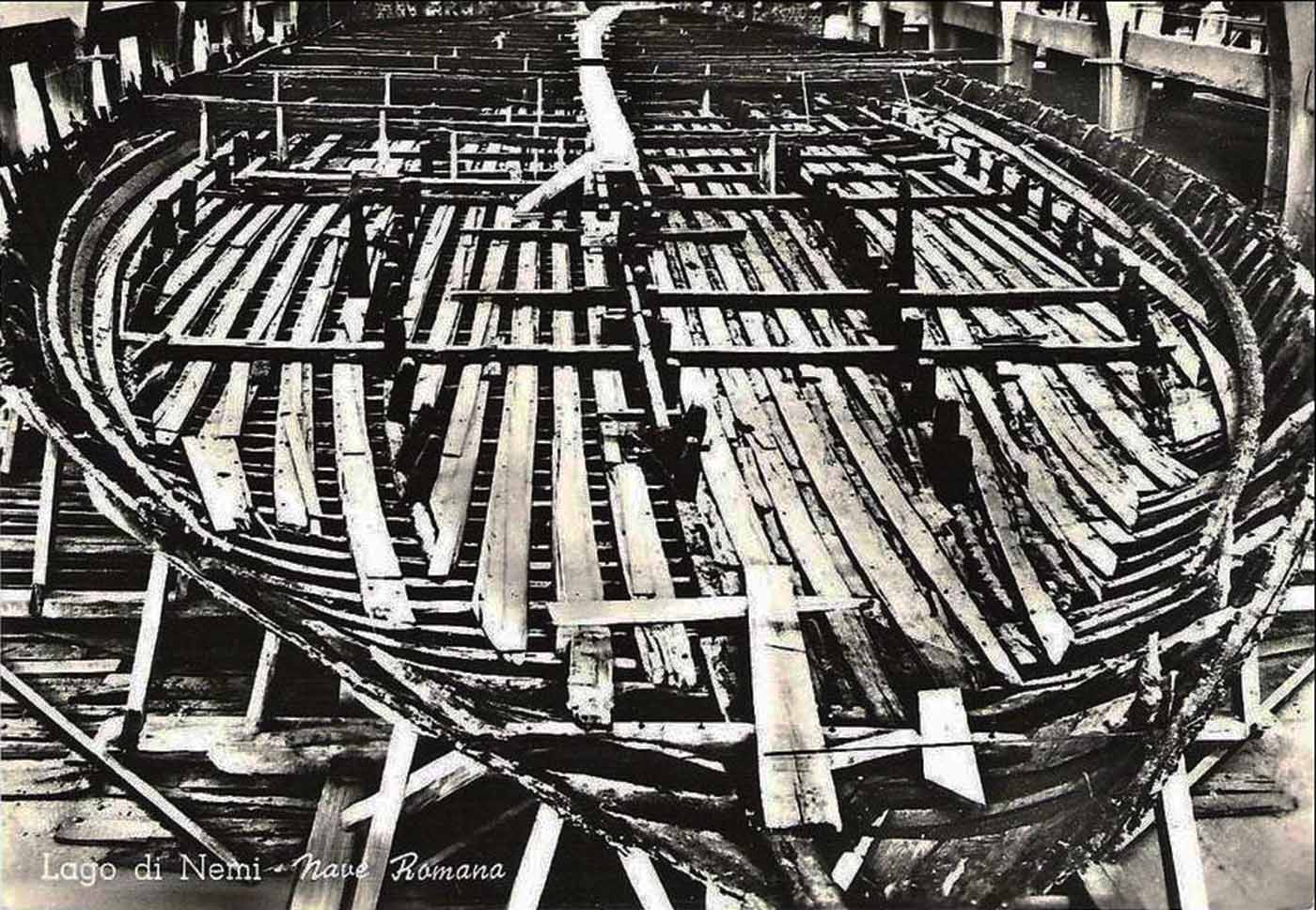
Local fishermen had always been aware of the existence of the wrecks, and had explored them and removed small artifacts, often using grappling hooks to pull up pieces, which they sold to tourists.
As one of his royal passions, Emperor Caligula ordered several large barges to be built to use on Lake Nemi. The two vessels, which were designated in modern times as Prima Nave and Seconda Nave , (First Ship and Second Ship), had dimensions of 70m x 20m (230ft x 66ft) and 73m x 24m (240ft x 79ft) respectively.
While there can be little doubt that the ships were built at the capricious whim of a spendthrift despot, their intended purpose and eventual use have long been the subject of debate by scholars and historians. Some contend that Caligula built the barges to show the rulers of Syracuse, Sicily, and the Ptolemaic rulers in Egypt that Rome could match any luxurious pleasure barges that they built.
Other scholars argue that Caligula designed one of his ships as a floating temple to Diana and some say that the other ship may have been used as a floating palace where Caligula and his court could indulge in the depravities that history has credited to him.
Seutonius, the Roman historian described the two biggest barges as being built of cedar wood adorned with jeweled prows, rich sculpture, vessels of gold and silver, sails of purple silk, and bathrooms of alabaster and bronze. The floors were paved with glass mosaic, the windows and door frames were made of bronze, and many of the decorations were priceless.
The Romans made ball bearings out of the lead and they probably used the ball bearings on the Nemi ships to make the statues of the gods rotate or to move the windlasses. The flat-bottomed Nemi barges were not self-propelled.
Instead, they were attached to the shore by chains and bridges stretching across the water so people and commerce could travel back and forth. According to some historical accounts, Caligula’s ships were the scenes of orgies, murder, cruelty, music, and sport.

Some contend that Caligula built the barges to show the rulers of Syracuse, Sicily, and the Ptolemaic rulers in Egypt that Rome could match any luxurious pleasure barges that they built.
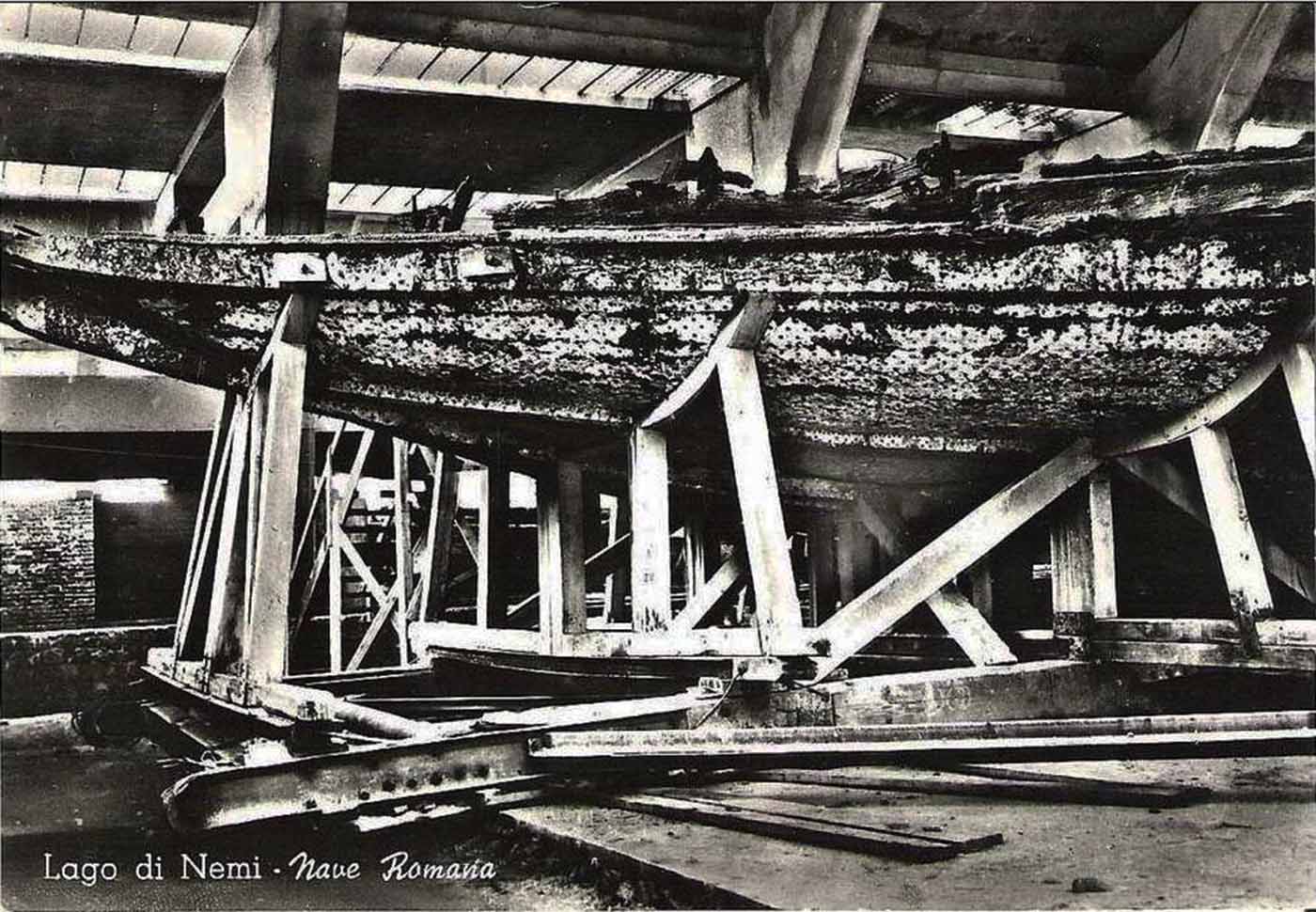
The two vessels, which were designated in modern times as Prima Nave and Seconda Nave, (First Ship and Second Ship), had dimensions of 67m x 19m and 71m x 24m respectively.
In 1446, Cardinal Prospero Colonna and Leon Battista Alberti followed up on the stories regarding the remains and discovered them lying at a depth of 18.3 meters (60ft), which at that time was too deep for effective salvage. They caused significant damage to the ships by using ropes with hooks to tear planks from them.
The Fascist government of Benito Mussolini worked to recover Caligula’s ships for about five years – from October 1928 to October 1932. Mussolini ordered antiquarian Guido Ucelli, the Italian Navy, engineers of Civil Engineers, industry, private individuals, and archaeologists to drain Lake Nemi.
The local people and archaeologists knew of an ancient Roman underground tunnel that connected the lake to farms outside the crater and they connected it to a floating pumping platform. Using powerful pumps and water scooping machines, the workers lowered the level of the lake and by June 10, 1931, they had recovered the first ship and the second had been exposed.
By this time the water level had dropped more than 20 meters (66ft) with over 40 million cubic meters of water removed. A London Times story reported that everyone on the site cheered as the waters receded to reveal the first Nemi ship. After nearly 1,900 years at the bottom of Lake Nemi, the ships again rode the waves.
The devastation caused by previous attempts at lifting was all too apparent from the time the ship became visible. Practically all of the original upper-works had been torn off and what remained lay in a jumble inside the hull with a multitude of other artifacts.

Benito Mussolini attending the inauguration of Museum of Nemi (Il Museo delle Navi Romane).
The ships were destroyed by fire in World War II on the night of May 31, 1944. Several US army shells hit the Lake Nemi Museum around 8 pm, causing little damage but forcing the German artillery to leave the area. Then a few hours later, smoke arose from the Museum and soon the two ships were burnt to ashes although the museum’s concrete structure suffered little damage.
The Lake Nemi Museum was restored and reopened in 1953. Photographs, drawings from the Italian Navy survey, and drawings of archaeologist G. Gatti also survived the fire, allowing artists and architects to make reconstructions of the two ships.
The spaces that once held the two immense Nemi Ships are now filled by one-fifth scale models built in the naval dockyard near Naples, and bronzes and other artifacts that survived the fire. Outside the Lake Nemi Museum, a life-size reconstruction of the sailing ship’s hull is displayed.
Emperor Caligula’s Nemi ships
By 1827, interest had revived to recover Caligula’s ships. Annesio Fusconi built a floating platform from which to raise the wrecks however, several of his cables broke so he called a halt until he could find stronger cables. When he returned, he found that the locals had dismantled his platform to make wine barrels leading to him abandoning the project.
The discovery proved that the Romans were capable of building large ships. Before the recovery of the Nemi ships, scholars often ridiculed the idea that the Romans were capable of building a ship as big as some ancient sources reported the Roman grain carriers were. Piston pumps supplied the two ships with hot and cold running water via lead pipes.
The hot water supplied baths while the cold operated fountains and supplied drinking water. This plumbing technology was later lost and only re-discovered in the Middle Ages.
The emperor Caligula had a very brief reign. He ruled from 37A.D. to 41A.D. for a period of three years and ten months. He is generally depicted by historians as a cruel megalomaniac who was noted for many excesses, not the least of which was his ability to squander, in a year, the entire resources of the Imperial treasury that had been built up by his predecessor Tiberius, on extravagant but useless schemes.
Caligula’s brief reign came to an abrupt end when he was assassinated by members of the Praetorian Guard, who were sickened by his depraved behavior and reckless expenditure. He was twenty-eight years of age.
Updated on: November 25, 2021
Any factual error or typo? Let us know.
| Feb 2 2016 | |

You’ve won a colonial war of choice by shattering a non-violent Ethiopia as world powers such as Britain and France stood by and watched. You’ve rammed through privatizations, laws favoring the wealthy, and made unions virtually illegal. And you’ve got an ultra-nationalist, militarized police force to help you crush social unrest. What does a satisfied dictator do to unwind? Clearly, he takes his yacht out for a spin on the Tyrrhenian Sea. Italian strongman Benito Mussolini used that yacht—the Fiamma Nera or “Black Fire”—for aquatic romps with his hot mistress Clara Petacci, but scuttled the boat in 1943 after Italy’s World War II fortunes turned for the worse. The boat was raised and had several owners over the decades, but is in the news today because it was part of € 28 million worth of assets seized from alleged organized crime figure Salvatore Squillante.
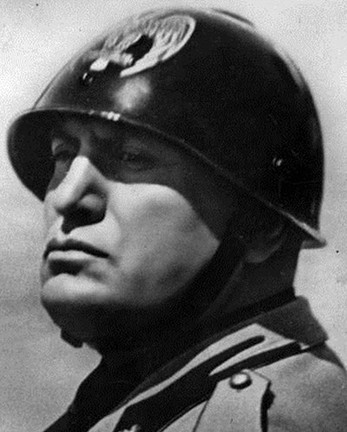
  Caligula’s Pleasure Ships of Lake NemiTwo thousand years ago, the debauched Roman emperor Caligula ordered the construction of two large floating pleasure barges on the relatively small Lake Nemi so that he could indulge in many of the depravities attributed to him. Lake Nemi is a small, shallow crater lake in the Alban Hills, approximately 30 km southeast of Rome, that has long been a vacation getaway for Romans, and now Italians, from the intense summer heat. Emperor Caligula, like his predecessor Emperor Tiberius, liked to spend his summers sailing in Lake Nemi. 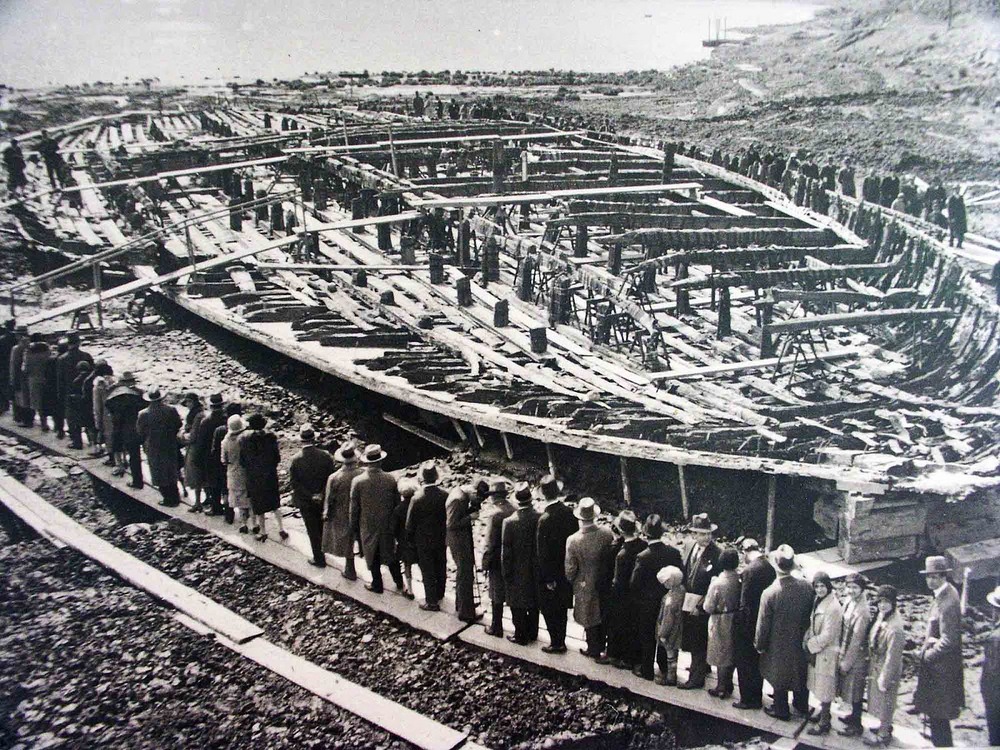 Caligula ordered two large ships, more than 70 meters long, which he intended to use during his vacations. One ship was a floating temple dedicated to the goddess Diana. The other was a floating pleasure palace. Both ships were of nearly identical size, with one slightly larger than the other. The larger one was dubbed prima nave (first ship), and the smaller was called seconda nave (second ship). The ships were meant to be anchored in place, and therefore had no means of propulsion such as sails, although they did have large rowing stations with long oars that was used to steer the ships. The ships had large marble palaces ostensibly decorated with mosaics, gemstones, statues, marble paving stones, gilded copper roof tiles, and fruit gardens. The palaces were equipped with plumbing and had hot water delivered to the baths through lead pipes. Despite the immense cost at which they were constructed, these opulent palaces were afloat only for a brief time, most likely a year or two, before Caligula’s four year reign came to an end. He was assassinated by an alliance of Praetorian Guard, senators, and courtiers in 41 AD. Shortly after his death, the ships were sunk intentionally. They settled in shallow water at a depth of about 20 meters, a short distance away from the shore area where they were built and docked. 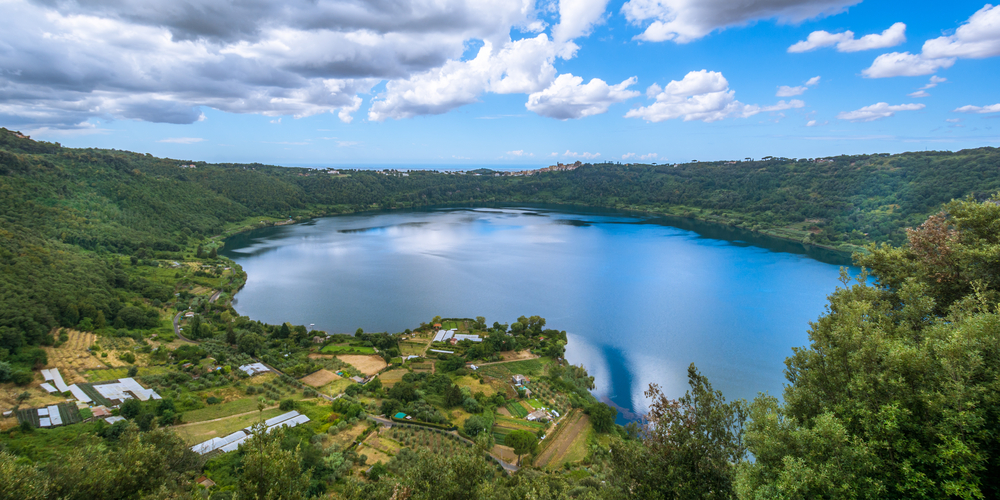 Lake Nemi. Image credit: Stefano_Valeri/Shutterstock.com Caligula’s ships were gone, but not forgotten. Throughout the medieval period, local fishermen used grappling hooks to pull up pieces of the ship and small artifacts which they sold to tourists. The first attempt to recover the ships was commissioned by Pope Prospero Colonna in the mid-1400s. A floating platform was made and expert divers brought from Genoa were sent down to the bottom. But the ships were too massive to the brought to the surface. All they managed was to tear off some planks. The second attempt took place in 1535 under the direction of Francesco De Marchi. He personally plunged into the lake using a diving bell, and recovered many items of marble, bronze, copper and lead. The timber beams he carved into walking sticks and boxes. It would need another four hundred years and the audacity of a fascist dictator to uncover the ships. In 1928, Benito Mussolini ordered the whole of Lake Nemi to be drained so that the ships could be recovered. Engineers reactivated an ancient Roman underground water conduit linking the lake to farms outside the crater and began pumping water. Five months later, the first ship broke the surface. Two years later, the second ship was exposed. By this time over 40 million cubic meters of water was removed from the lake, and its level had dropped more than 20 meters. Then something curious happened. The lake bed, released of this enormous weight, began to bounce up and erupted in mud flows. This caused the lake floor to subside threatening the exposed ships. Work was suspended for almost a year. The second attempt at draining the lake was successful, and both ships were freed from the mud and carefully transported to dry land, where a museum was built to house them. The museum was inaugurated in 1936. On the night of May 31 1944, less than four years after Italy entered the Second World War, the museum along with both ships was razed to the ground. It is not known whether the fires were started because of US bombing or German arson. Both parties blame the other. The ships were almost totally destroyed. Only some bronzes and materials that were already moved to museums in Rome survived. Today, only scaled replicas of the ships exist at the museum. 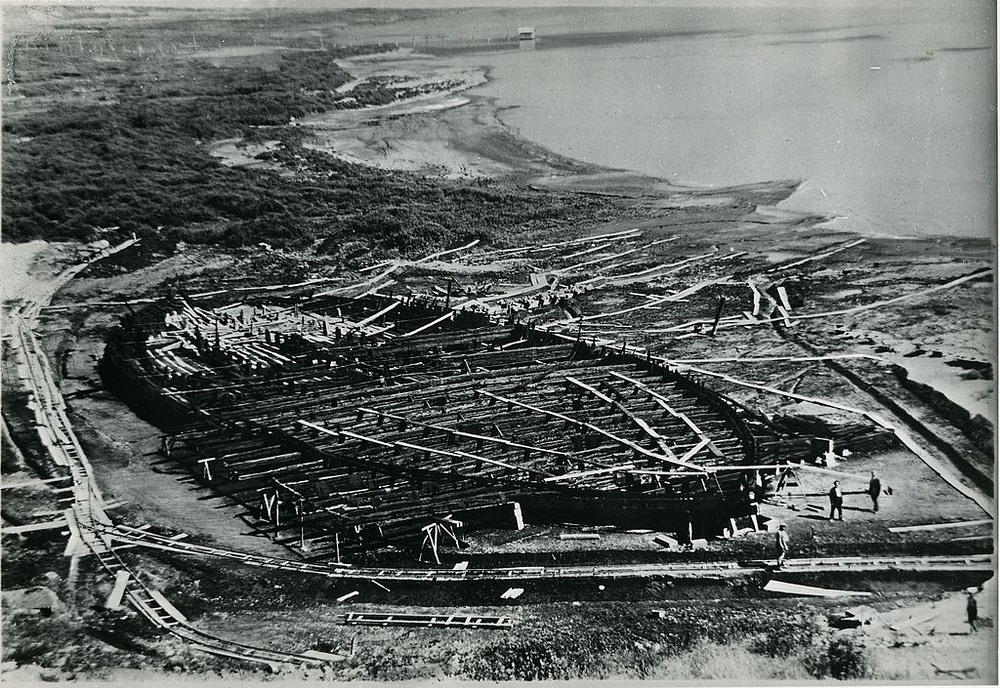 Benito Mussolini attends the inauguration of the museum housing the Nemi ships.  More on Amusing Planet{{posts[0].title}}{{posts[1].title}}{{posts[2].title}}{{posts[3].title}}Advertisement, featured articles, top countries.
Bodies of 2 children recovered from Lake Michigan identified as those missing from capsized sailboat
 U.S. Coast Guard and partner agencies are searching for an adult and two children from an overdue 18-foot sailing vessel that originally departed from Green Island in Green Bay, Wisconsin, at approximately 4 p.m. on July 13. U.S. Coast Guard
The bodies of two children recovered from Lake Michigan on Monday have been identified as those who were missing from a capsized sailboat that was found earlier that day, authorities said. Charlotte Salnik, 5, and Joshua Salnik, 3, were recovered from Green Bay south of Chambers Island, about three nautical miles from where their family’s sailboat was found, the Oconto County Sheriff’s Office announced Wednesday. Autopsies were conducted Tuesday, police said, but official causes of death have not been released. Their father, Bill Salnik, 32, of Little Suamico, Wis., remains missing. He was the only other person aboard the sailboat. “All search operations will continue with no plans to suspend until further notice,” the sheriff’s office said. The effort includes drones and K9 assisted marine searches, police said. RELATED: Bodies of 2 children recovered from Lake Michigan after capsized sailboat found The family was last heard from around 4 p.m. Saturday when they departed from Green Island in Lake Michigan’s Green Bay. They were expected to return to a marina near Oconto, Wis., but never arrived. Officials were notified that they were missing Sunday afternoon. Salnik’s truck and trailer were found at the boat launch. His phone was going straight to voicemail. At 6:22 a.m. Monday, the capsized 18-foot Gulf Coast Sailboat was found just south of Chambers Island. It was towed to shore. No one was found near the vessel and the search continued. Charlotte and Joshua were found Monday afternoon.  Most Popular Stories by Justine Lofton
If you purchase a product or register for an account through a link on our site, we may receive compensation. By using this site, you consent to our User Agreement and agree that your clicks, interactions, and personal information may be collected, recorded, and/or stored by us and social media and other third-party partners in accordance with our Privacy Policy.
Italian police seize Mussolini’s yacht from businessman linked to mafia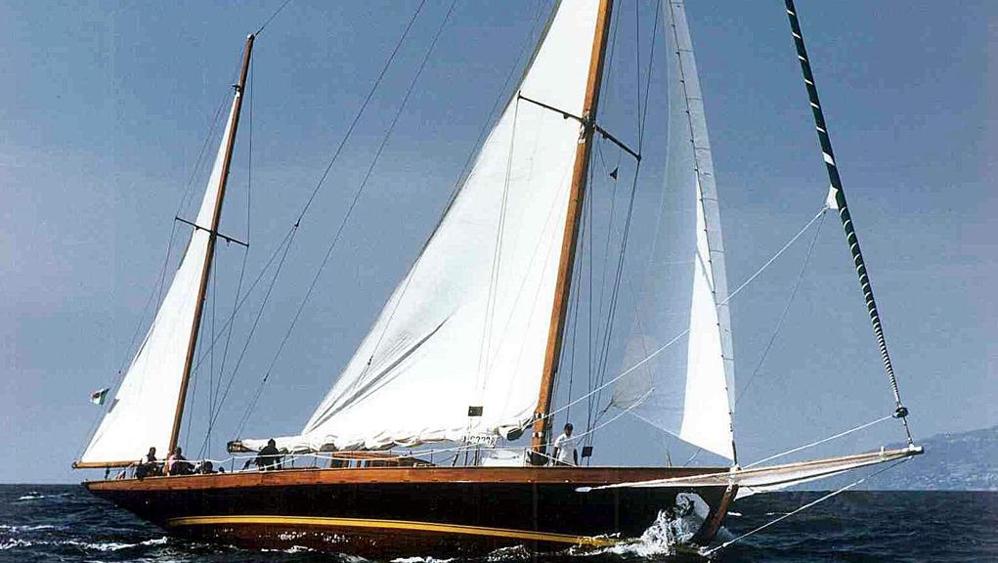 Italian police said on Monday they had seized a yacht that once belonged to Fascist dictator Benito Mussolini from a businessman possibly linked to a huge organised crime network. 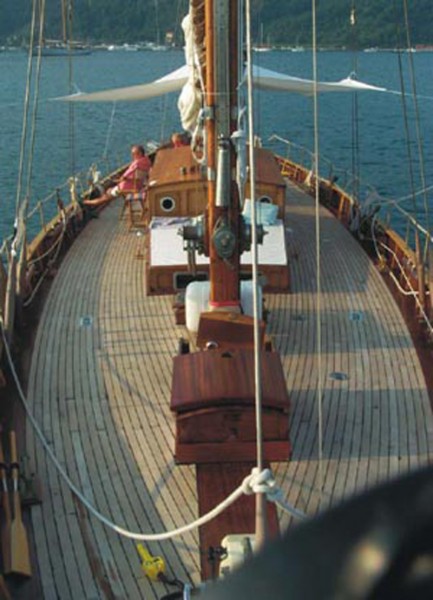 The yacht was among 28 million euros (US$30.5 million) worth of assets including real estate, luxury cars and company stakes sequestered in an investigation into three individuals and 10 companies, the finance police said in a statement. 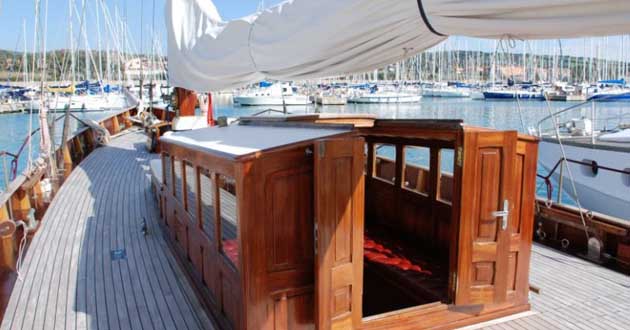 A confiscation order from a Rome court named the businessman as Salvatore Squillante, 68. The lawyer named in the order as acting for Squillante declined to comment. The finance police did not name the businessman. 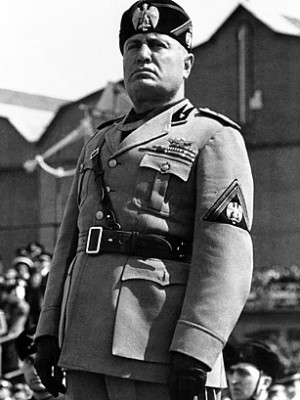 The boat was deliberately sunk in 1943 to stop it falling into German hands after the Fascist regime fell, and was then hauled out and restored after the war. The court document said Squillante, who served a community service sentence for a 1993 fraudulent bankruptcy, made business deals that suggested he might be linked to a Rome-based mafia network run by a former neo-fascist gangster. He rented property to a firm owned by convicted murderer Salvatore Buzzi, who is accused of being a prominent member of the crime ring that allegedly skimmed millions of euros off city hall contracts in Rome. His activities “could raise suspicions of a possible hidden pact between this man and members of organised crime (groups) to share out money from contracts to manage migrant reception awarded by the (Rome) administration”, the court document said. During the “Capital Mafia” investigation, police who had tapped Buzzi’s telephone recorded him saying the drug trade was less lucrative than schemes involving migrants. 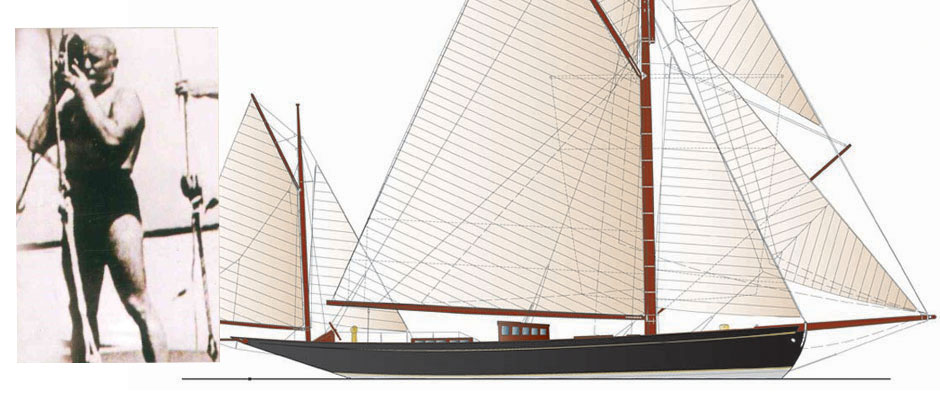 Share this articleYou might like. 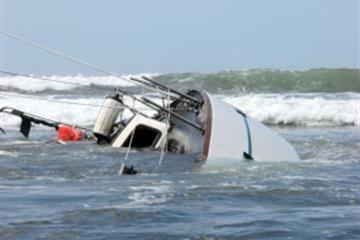 Sign up to our newsletterBy submitting this form, you agree to our Privacy & Cookie Policy Change units of measureThis feature requires cookies to be enabled on your browser. Show price in: Show lengths, beam and draft in: Show displacement or weight in: Show capacity or volume in: Show speed in: Show distance in:  Bill Shepler, captain and co-founder of Mackinac Island ferry fleet, passes away The captain and co-founder of Shepler's Mackinac Island Ferry, known for his personable nature and perfectionism when it came to customer service, has died, the company announced Thursday. "Bill's dedication and passion for connecting people to the beauty of Mackinac Island created unforgettable memories for countless guests," the company said in a statement on Facebook. "His legacy of service, leadership and community spirit will forever be a part of our lives." Shepler was 92. A cause of death was not listed. Bret Marr, a Lansing lobbyist whose firm represented the ferry company, remembered Shepler as a "great ambassador" for the Pure Michigan tourism campaign who loved talking to out-of-state visitors and encouraged Michiganians to visit the Straits of Mackinac during the last few weeks of the summer season. "He knew everybody's name," Marr said. "You met him once, you knew him for life." Marr added that despite the ubiquity of the Shepler's blue-and-white ferries, Shepler didn't take it for granted. "I think that's why, even in his 80s, you would still see him up there schlepping luggage; helping people unload their cars," Marr said. "He was just another team member." According to the company's website, Shepler's father Capt. William Shepler started the company as a snack bar for passengers waiting for the ferry to Mackinac Island after he went home to Mackinaw in the spring of 1945. The first two boats used by the company, one of which Bill Shepler piloted, were named "Miss Penny" after the captain's daughter and "The Fiji" after Bill Shepler's fraternity. The company added a boat called the "William Richard" to its fleet in 2020. Dan Musser, the former owner of the Grand Hotel on Mackinac Island and the current chair of Arnold Freight Company, said he knew Shepler all his life. He remembered Shepler as committed to making sure guests coming to the island had a good experience on their way. The few times he had the chance to be at the fleet's Mackinaw City dock, Musser said, Shepler was there, greeting people and even cleaning the ferry boats. For most visitors to Mackinac Island, Shepler's ferry boats were their first impression of an island without cars. "And he did it with great efficiency and flair," Musser told The Detroit News. Cleanliness was one particular point of pride for Shepler, Musser said. "I know how hard it is to keep a boat clean," Musser said. "Mr. Shepler really perfected that." Shepler's Mackinac Island Ferry sold in 2022 to Naples, Florida-based Hoffmann Family of Companies, but the Shepler family remained partial owners and stayed involved in the day-to-day operations. A division of Hoffmann also recently acquired Mackinac Island Ferry Co., another ferry boat operator that runs ferries across the Straits of Mackinac from Mackinaw City and St. Ignace, according to an announcement in June. Advertisement Amid the Mayhem, Trump Pumped His Fist and Revealed His InstinctsA bloodied Donald J. Trump made Secret Service agents wait while he expressed his defiance. The moment epitomized his visceral connection with his supporters, and his mastery of the modern media age.
 By Shawn McCreesh
Donald J. Trump was back on his feet. He had just been shot at, his white shirt was undone and his red hat was no longer on his head. Blood streaked across his face as riflemen patrolled the perimeter of the stage. A pack of Secret Service agents pressed their bodies against his. “We’ve got to move, we’ve got to move,” one pleaded. “Wait, wait, wait, wait,” the former president instructed, his voice a harried — but startlingly clear — command. Reluctantly, they halted. He peered out into the crowd. And then his arm reached toward the sky, and he began punching the air. The crowd started to chant — “ U-S-A! U-S-A! ” — as the agents inched Mr. Trump toward the stairs. When they reached the top step, they paused once more, so Mr. Trump could lift his arm a little higher, and pump his fist a little faster. The crowd roared a little louder. It’s difficult to imagine a moment that more fully epitomizes Mr. Trump’s visceral connection with his supporters, and his mastery of the modern media age. Mr. Trump would not leave the stage without signaling to his fans that he was OK — even as some were still wailing in fear. And he did not just wave or nod, he raised his fist in defiance above his bloodied face — making an image history will not forget. He has always been highly conscious of how he looks in big moments, practicing his Clint Eastwood squint and preparing for his mean mug-shot grimace. But there was no time to prepare for this. This was instinct. As the agents coaxed him onto his feet, he stammered, “Let me get my shoes on, let me get my shoes on.” “I got you, sir, I got you, sir,” an agent replied. Mr. Trump rose, his voice uneven at first, still repeating himself: “Let me get my shoes on.” “Hold that on your head,” an agent told him, “it’s bloody.” “Sir, we’ve got to move to the cars,” another said. “Let me get my shoes on,” Mr. Trump said again. Fierce one moment, he looked drained and stricken the next. After the agents managed to hustle him off the stage, they led him toward an idling Chevrolet Suburban. He began to clamber inside, but before the door could close, he turned back toward the crowd again. His head appeared more blood-soaked than before. He raised his fist one more time. Our Coverage of the Trump Rally ShootingThe Investigation : F.B.I. officials told Congress that the 20-year-old gunman who tried to kill Donald Trump used his cellphone and other devices to search for images of Trump and President Biden . Security Blind Spots : Even as investigators continue to examine what happened at the Trump rally, it is already clear that there were multiple missed opportunities to stop the gunman before the situation turned deadly. The Gunman : In interviews, former classmates of the suspect described him as intelligent but solitary , someone who tried to avoid teasing by fellow students. Secret Service Director : Kimberly Cheatle returned in 2022 to lead the agency she had served for nearly 30 years. Now, the assassination attempt on Trump has thrown her tenure into uncertainty . Fears of What’s Next : Among voters, there is growing anxiety that America’s political divide is nearly beyond repair, and the shooting only made things worse .
How Mussolini Seized Power in Italy—And Turned It Into a Fascist StateBy: Fred Frommer Updated: September 15, 2023 | Original: April 11, 2022  Before becoming one of the most famous fascists of the 20 th century, Benito Mussolini was a young socialist, but he split with the movement and then rode a wave of anti-socialist violence to power in Italy. Benito Amilcare Andrea Mussolini’s middle names came from Italian socialists Amilcare Cipriani and Andrea Costa , and his father was a socialist. In his 20s, Mussolini briefly edited a socialist newspaper in Austria-Hungary, then in 1912, when he was around 30, he took over as editor of Avanti! (Forward!), the official daily newspaper of Italy’s Socialist Party. But a couple of years later the party expelled Mussolini over his support for Italy’s entrance into World War I . “Mussolini was more of an authoritarian revolutionary than an orthodox Marxist,” says Michael R. Ebner, an associate professor of history in the Maxwell School at Syracuse University, and the author of Ordinary Violence in Mussolini's Italy (Cambridge University Press, 2011). “With the outbreak of World War I, he came to see nationalism and militarism as the keys to revolutionary upheaval. He therefore left behind Marxist economic determinism and pacifism.” After WWI, Mussolini's 'Blackshirts' Target Socialists Mussolini might have left the Socialist Party behind, but many Italians embraced it after the war, in part because establishment politicians were ineffective in solving postwar problems, says Ebner, who is also co-editor of The Politics of Everyday Life in Fascist Italy ( Palgrave Macmillan, 2017). “After the sacrifices of the war, and the example of the Bolshevik Revolution in 1917, anything seemed possible,” he says, adding that Socialists made huge electoral gains, taking over local governments, which alarmed some middle- and upper-class Italians. Seeing those gains, Mussolini took on the Socialists by force. In 1919, Mussolini created the Fasci Italiani di Combattimento , (Italian Combat Squads), the precursor to his Fascist Party. This group engaged in violence against Socialists and other enemies. In 1921, he founded the Fascist Party, turning his paramilitary movement into a formal political party. He coined the name of the party based on the Italian word for bundle— fascio —in reference to bundles of rods used in ancient Rome to symbolize strength through unity. The party emphasized national unity—even if it required violence to keep dissenters in check. “Basically, Mussolini hated the Socialists, and so did the rest of the Fascists,” Ebner said. “One driving force behind Fascist violence was their desire to punish the Socialists for not supporting Italy during the Great War (World War I). The Fascists viewed the Socialists as cowardly traitors, internal enemies, who needed to be eradicated.” He noted Mussolini’s paramilitary groups that attacked the Socialist Party and labor unions—known as the Blackshirts—were often paid or supplied by wealthy landowners. Fascist squads burned down Communist and Socialist offices as they took over cities. Italy's King Asks Mussolini to Form GovernmentIn 1921 Mussolini was elected to the lower chamber of Italy's parliament, the Chamber of Deputies, and the next year, tens of thousands of armed Fascists marched on Rome, demanding Mussolini be named prime minister. Italy’s King, Victor Emmanuel III, refused to declare a state of emergency and impose martial law. Instead he dissolved the government and asked Mussolini to form a new one. Mussolini became both prime minister and interior minister, the latter post, critically, giving him control over the police. Before Mussolini became prime minister, Fascist squads had used violence to kill, harm, frighten, and humiliate their enemies. After Mussolini became prime minister in October 1922, the squads were still important, but Mussolini could also then rely on the police to go after enemies like Communists, Socialists and Anarchists. “Mussolini could therefore mix 'legal' state repression with 'illegal' squad violence,” Ebner says. “The police found cause to arrest and harass left-wing political opponents, while the squads could engage in beatings and assassinations to silence other critics.” The Rise of Mussolini's Cult of Personality In June 1924, assassins with ties to Mussolini killed socialist leader Giacomo Matteotti , prompting opposition deputies to boycott the Parliament. On January 3, 1925, Mussolini essentially took responsibility for that assassination in a speech to Parliament that is seen as the start of his Fascist dictatorship . “I declare before this Chamber, before the world and before God that I personally assume the whole political, moral and historical responsibility for what has occurred,” he told the Chamber. “I declare that if the Fascists are an association of malefactors, then I am the head of that association of malefactors.” In response to what he called “scandalous” press attacks against Fascism, Mussolini said, “The whole nation is asking what the government is doing, the whole nation is asking whether it is governed by men or by puppets.” “Standing in his characteristic pose,” the New York Times reported , “with chest well thrust out, thumping the Ministers’ bench with his tightly clenched fist to emphasize his points… he spoke with fire, passion and vehemence … Only force, he said, can decide between Fascism and the Opposition, and this force he now proposes to use.” Attendees stood and applauded every sentence, and shouted “Vivo Mussolini! Vivo Fascismo!” “It was the greatest triumph of Mussolini’s whole political career,” the Times said. After his speech, “Deputies rushed at Mussolini from all sides and lifted him shoulder-high carrying him in triumph out of the chamber,” while others danced and sang. Mussolini, known as “ Il Duce ” (the Leader), ruled as a dictator from that point on. He fostered a cult of personality, projecting himself as an omnipotent and indispensable leader. His government expelled all opposition, including Socialist members and arrested all Communist members of Parliament. He abolished local elections and reinstated the death penalty for political crimes. Mussolini's government also required movie houses to show government propaganda newsreels as part of a crackdown on the free press. In “ The Doctrine of Fascism ,” published in 1932, Mussolini and a fellow Fascist described the state as "all-embracing; outside of it no human or spiritual values can exist, much less have value." Mussolini Allies With Hitler, Then Executed at Close of WWIIMussolini allied with German dictator Adolf Hitler in World War II , and ruled Italy until 1943 when he was voted out of power by his own Grand Council and arrested. After German commandos rescued him, he was placed atop a puppet government in German-occupied northern Italy from September 1943 to April 1945. As the Third Reich lost its grip on northern Italy, Mussolini attempted to flee with his mistress to Switzerland. He wore German clothing and a helmet to try and disguise his identity, but, thanks to his years of promoting his cult of personality, he was quickly recognized. Mussolini was executed along with his mistress by Italian Communist partisans on April 28, 1945.  HISTORY Vault: World War IIStream World War II series and specials commercial-free in HISTORY Vault.  Sign up for Inside HistoryGet HISTORY’s most fascinating stories delivered to your inbox three times a week. By submitting your information, you agree to receive emails from HISTORY and A+E Networks. You can opt out at any time. You must be 16 years or older and a resident of the United States. More details : Privacy Notice | Terms of Use | Contact Us Rome on Rome Mussolini’s Architectural Legacy in RomeRome is a very old city, by most estimates, over 2800 years old. You can literally wander from the 8 th century BC to the 21 st century in a day’s walk. The architectural styles of Rome are just as eternal as the city itself. The Classical city was mostly built between the 1st century BC and the 4 th century AD. The Christian city (Byzantine, Medieval, Renaissance and Baroque periods) stretches from the 4 th to the 18 th century.  He was 39 years old when he became the Prime Minister of Italy in 1922. His desire to restore the ancient grandeur of the Roman Empire might have started as a utopian socialist dream of equality, but it soon mutated into a nightmare of an autocratic totalitarian empire. Mussolini became Il Duce , a term derived from the ancient Roman title Dux (leader). In 1934, at the completion of the Via dei Fori Imperiali , the avenue that bisected the ancient Imperial forums of the Roman Emperors, Mussolini installed 5 marble and bronze maps on the exterior wall of the 4 th century AD Basilica of Maxentius. 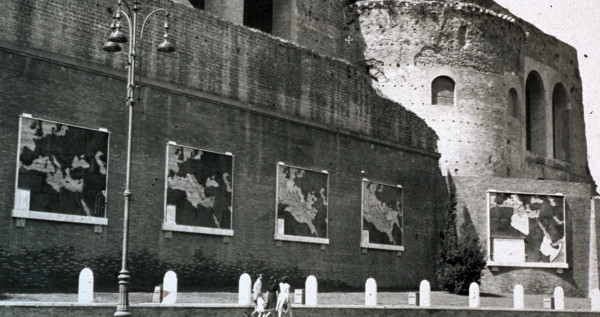 Four of the maps are still there. The 1 st map marked the birth of Rome in 760BC. The 2 nd map showed a larger Rome after the Punic Wars in 146BC. The 3 rd map showed the enlarged empire of 14AD under the Emperor Augustus. The 4 th map increased Rome to the furthest extent of the Empire under the Emperor Trajan in the 3 rd century. The 5 th map was Mussolini’s vision of the new Roman Empire that included Albania, Croatia, the Balkans, France’s Corsica and Nice, Greece, and eastern Africa from Tunisia, Libya and Egypt through the Sudan to Ethiopia and Somalia. He did conquer all of Libya in 1934 (although the Italian invasion of the area began in 1911), Ethiopia (1936) and Albania (1939) but the rest never happened. The 5 th map was damaged after the war and disappeared for a while. It was rediscovered in the early 2000s and placed in storage ever since. Mussolini’s reign ended on April 28th, 1945 when he and his mistress, Clara Petacci, were captured and killed by Communist Partisans on the shores of Lake Como. On April 29th, the following day, their bodies were suspended from the rafters of a Milan gas station in Piazzale Loreto . He was 61 years old. On April 30th, Adolf Hitler committed suicide. World War II was coming to an end. During his 21 years in power, Benito Mussolini changed the face of Rome forever, even though he destroyed hundreds of buildings and displaced thousands of people to do it. RATIONAL ARCHITECTUREWhile Mussolini’s Fascism was echoed through blood pumping rallies, military parades, propaganda films and pro fascist newspapers, his new Rome was built with wide 4 lane boulevards and propaganda architecture created by Italy’s Rational Architecture Movement . The Rationalists embraced the sleek minimal modernist buildings of concrete, steel and glass, but they also retained a reverence for ancient classical lines with stylized columns, pediments, porticos, domes and arches. 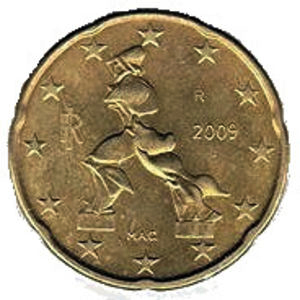 Rationalism grew out of the Italian Futurism Movement of 1909-1914, an artistic movement that ended with the outbreak of World War I. One of the leaders of the Futurists, Umberto Boccioni has been commemorated on the obverse side of the Italian issued 20 cent euro coin with an image of his 1913 masterpiece ‘Unique Forms of Continuity in Space’. Italian Futuristic Architecture never really made it off the page. The most celebrated architect of the movement, Antonio Sant’Elia, was born on the shores of Lake Como in 1888 and died in 1916 along the Isonzo Front of World War I. Many of the Futurists died in the War. Patriotism and violence were part of the Futurist manifesto. 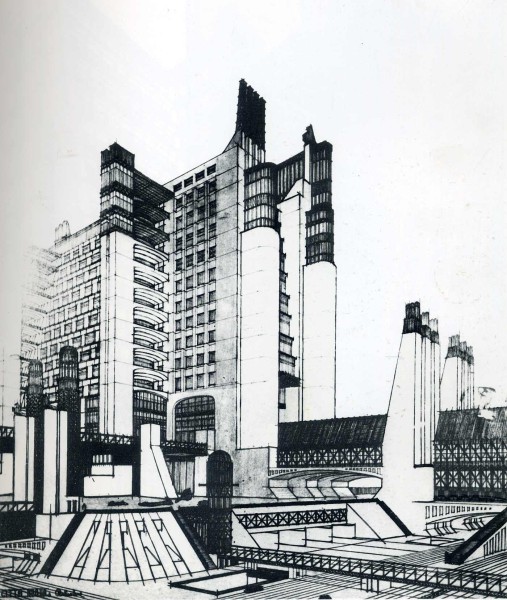 Even though his career barely spanned 9 years, Sant’Elia’s imagination and designs have influenced people from Fritz Lang’s Metropolis to John Portman Hotels to Ridley Scott’s Blade Runner to Helmut Jahn’s State of Illinois Center in Chicago . In 1931, the Fascist party commissioned the Terragni brothers (Guiseppe and Attilio) to create a memorial to the fallen Italian soldiers of World War I. Part of Mussolini’s new empire was to change the sadness of the Italian losses of World War I into the heroic reverence and military idealism of the ancient Romans. 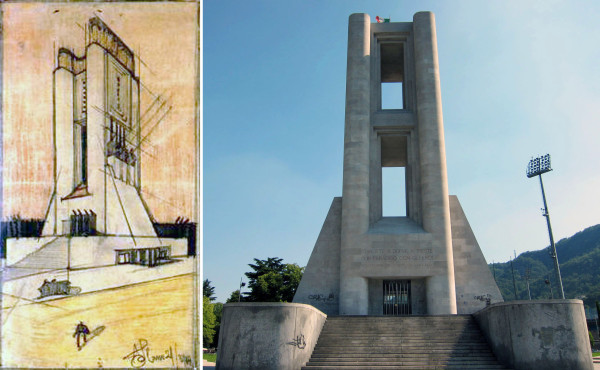 The Terragni brothers reimagined one of Sant’Elia’s drawings and created a 30meter tall homage along the waterfront of Como. The Monument of the Fallen (Monumento ai Caduti) honors 650 of the brave soldiers who died in the battles of the Isonzo Front. The epitaph of the façade facing Lake Como reads: Stanotte si dorme a Trieste o in Paradiso con gli eroi Tonight you sleep in Trieste or in Paradise with the heros. THE SYMBOL OF THE FASCESFor his iconic emblem of power, Mussolini adopted the ancient Roman fasces , a bundle of thin rods tied together around an axe head. A single rod might be easily snapped in two but a bundle of rods was unbreakable. The axe head buried in the midst represented the judicial power of the magistrates carried by their bodyguards known as the Lictors. The word Fascism is derived from the Roman fasces. The Rational Architecture in Italy during the Fascist period became known as Stile Littorio (Stile of the Lictor). Repurposing old icons was nothing new. The swastika was more than 5000 years old before it was appropriated by Hitler’s Nazi party. Even though the symbol has been banned in Germany and many other parts of the western world, it is still used as a holy symbol of good fortune for Hindus, Jains and Buddhists. The ‘fasces’ were banned in Italy after the war but there are still quite a few of them left. Italy is more willing to forgive and forget. 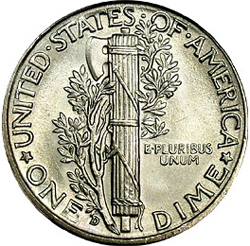 If you live in the US, you’ll see it in quite a few places. It used to be the engraving on the tails side of the Mercury Dime until it was replaced with the Franklin D Roosevelt dime in 1946. The fasces symbol still graces the arms of Lincoln’s chair in the Lincoln Memorial in Washington D.C.. It’s on the emblem of the Knights of Columbus. It’s included in the statue of George Washington in front of New York City’s Federal Hall National Memorial. It also flanks the American Flag behind the Speaker’s Podium of the chamber of the United States House of Representatives (as seen in the photo below).  It is the height of irony to see a US Politician refer to another member of the House as a fascist while standing in front of the fascist symbol. THE RAILROAD WAS THE CORE OF MUSSOLINI’S DEFENSE SYSTEM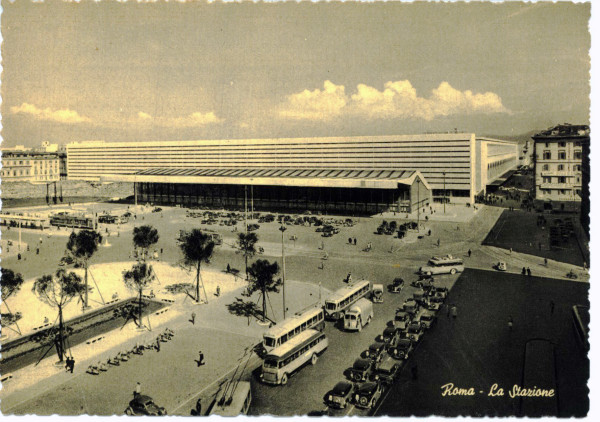 If you arrive to Rome by train, you will most likely arrive to the Termini Train Station (Stazione di Roma Termini).Although the current building was completed in 1950 by Annibale Vitellozzi, the original design by Angiolo Mazzoni broke ground in 1936. It was supposed to be completed for the 1942 Esposizione Universale Roma (EUR) but the World Expo never happened. The project was abandoned in 1943. There are still visible parts of the Mazzoni building. If you are facing the front of the building, go to the right, along the Via Giovanni Giolitti. This is all original. 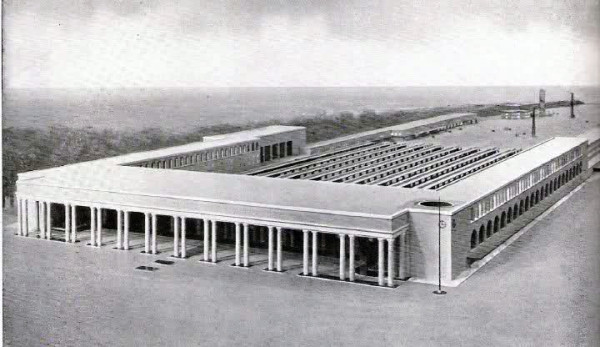 Angiolo Mazzoni and Roberto Narducci were architectural engineers of the Fascist period, mostly known for their train stations. They designed and built close to 50 train stations in Italy in the 1930s. Roberto Narducci was awarded the design of the new Ostiense Train Station near the Porta San Paolo and the Pyramid of Cestius. 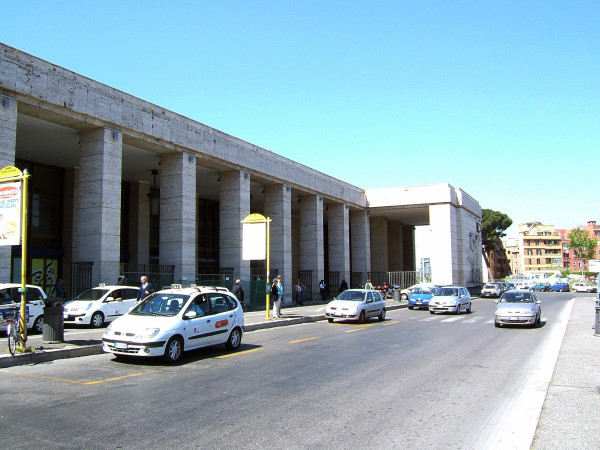 Narducci included mythological reliefs on the facade, black and white tesserae tiled floors in the station and a modernized nod to ancient Roman columns in the design. The road from the Piazza dei Partigiani along the side of the station to the Porta San Paolo was named Via Adolfo Hitler, but after the war, it was renamed Viale delle Cave Ardeatine, a sad reminder of the Nazi massacre of 335 Italians innocents in the quarries of the Ardeatine caves about 9km south of the train station. Mussolini gets the credit for a revitalized railroad system but it wasn’t really the entire story. In 1936, the American war correspondent and journalist, George Seldes, who referred to Mussolini as the Sawdust Caesar, wrote that it was true that the larger express trains filled with eye-witness journalists did run on time but the smaller lines with no reporters that ran on defective rails and bad roadbeds constantly caused delays. After World War II, Mazzoni, deeply regretful of his participation in the Fascist cause, went into a self imposed exile to Bogota, Columbia. He remained there until his death in 1963. Narducci died at in Rome in 1979, at age 91. MUSSOLINI CLEARED OUT THE SLUMS AND LIBERATED THE ANCIENT MONUMENTSMussolini’s grand boulevards were designed to open up the city and showcase the pomp and propaganda of the Fascist Military, kind of a modern day Triumph parade. Built in 1932, the Via dei Fori Imperiali is the most famous of the parade routes, linking his Palazzo in the modern Piazza Venezia to the ancient Coliseum. In order to achieve this all, he cut a swath through the ancient Imperial Forums of the Emperors Julius Caesar, Augustus, Trajan, Neva and Vespatian. He also tore down blocks of housing, medieval churches and displaced thousands of people. The Via dei Trionfi , now known as Via di San Gregorio, connected the Arch of Constantine to the Circus Maximus. It was proposed to connect the ancient monuments to Mussolini’s 1942 Expo, EUR. 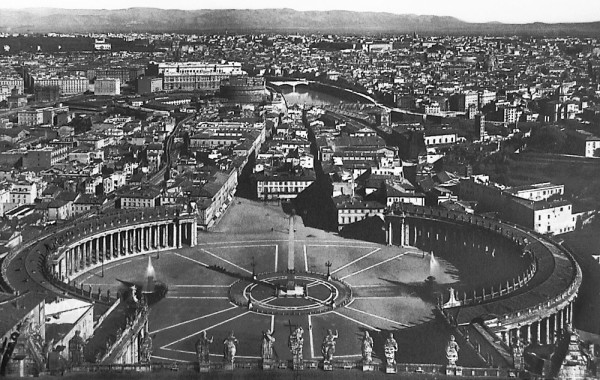 In order to align the Fascist government with the Vatican, in 1936, he built the Via della Conciliazione , another modernization and grand parade route connecting the Mussolini’s Rome with the Catholic Vatican. The Conciliazione is the reconciliation between the Fascist Government and the Vatican. Construction on the road wasn’t finished until 1950, five years after the death of Mussolini and Fascism. Gianlorenzo Bernini’s grand design of the Piazza of St Peter’s had the great embrace of the Church and the Piazza revealing it’s grandeur after coming through the dark and narrow medieval streets of the Borgo. The Via della Conciliazione forever changed his design. The Via Ostiense/Via del Mare connected the Porta San Paolo to the ancient seaport of Ostia. Mussolini’s archeologists excavated much of the ancient seaport between 1938 and 1941, hoping to get the ancient site ready for the failed 1942 Esposizione Universale Rome (EUR). More than 600,000 cubic meters of earth (up to 12 meters in depth) was removed to reveal the ancient street level. Other roads were constructed. Swamps were drained and new towns were built to handle all the displaced people. With larger roads in place and most of the poor slums destroyed, Mussolini, along with his main architect, Marcello Piacentini and his city planner, Antonio Munoz, liberated the ancient ruins from centuries of neglect and incorporate them into the plan of a new modernist city. 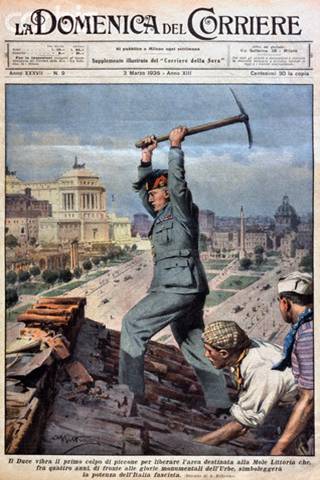 In order to expose the ancient site of the Circus Maximus, he moved a gas plant, tore down a pasta factory, dug up a 300 year old Jewish cemetery, destroyed a village of barracche (poor slum shacks) and excavated over 18’ of dirt and debris. By 1934, the ancient Roman racetrack was an open field used for Fascist Rallies and Expos. He removed more barracche slum houses from Porta Octavia and Teatro Marcello (now the gentrified Jewish Ghetto), destroying the final remains of Rome’s medieval fish market. As with all building projects, Il Duce, himself, would strike the first blow of demolition. He never missed an opportunity to swing an axe, roll up his shirtsleeves or strip down to the waist to show off his sculpted physique for a photo opportunity. The ancient Forums and the Arch of Constantine became a parade route, the Markets of Trajan were used for Trade Fairs and mini expos, concerts were held at the Basilica of Maxentius, rallies were staged at the Coliseum and large rallies and Fascist Expos were held in the Circus Maximus. The three largest urban renewal projects of Mussolini’s new city plan were the Piazza Augusto Imperitore around the Mausoleum of Augustus, the Foro Mussolini , a modern day center of sports, physical fitness and government and the Esposizione Universale Roma (EUR) , the Expo to the world of Mussolini’s new Rome. THE PIAZZA AUGUSTO IMPERITOREThese days, the Piazza Augusto Imperitore is known for the Ara Pacis Museum , the controversial 2006 Richard Meier building that houses the 9 BC Altar of Peace built after the Emperor Augustus returned to Rome victorious in the wars of Hispania (Spain) and Gaul (France). The Richard Meier Ara Pacis Museum was the first new building in the old historic area of Rome in over 60 years. 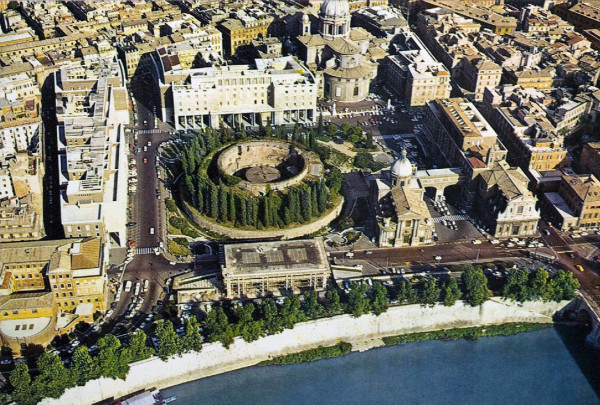 In 1937, Mussolini made plans to celebrate the Bimillennial (2000 th ) anniversary of the birth of the Emperor Augustus. The celebration would pay homage to the ancient glory of Augustus and the new glory of the Mussolini and the Fascists. The plan would demolish much of the old neighborhood surrounding the Mausoleum of Augustus and rebuild a new Piazza connecting a new museum built for the Ara Pacis altar with a restored Mausoleum of Augustus. Mussolini envisioned the Mausoleum as his own final resting place. At the other end of the Piazza would be the newly constructed Istituto Nazionale della Previdenza Sociale (The Social Security Headquarters). The man in charge was Vittorio Ballio Morpurgo , a Jewish Architect from Rome . He had only a year to complete the project before the Bimillenial Celebration. Augustus was born in 63 BC. The actual anniversary would have been in 1938. 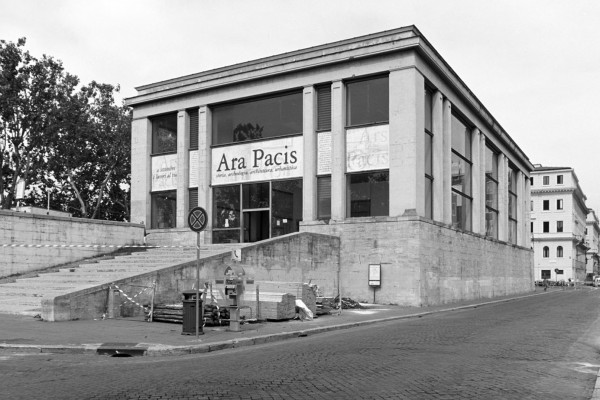 In order to complete the project on time, Morpurgo created a concrete shell painted to look like travertine marble with large windows to view the reconstructed ancient altar. The pieces of the ancient Altar of Peace were moved from their original location near the Palazzo Montecitorio, about 850 meters away, to the new location. Here is a wonderful archive film of Mussolini at the inauguration of the Ara Pacis Museum. After years of neglect and closure, the Morpurgo Museum was torn down in 2000. This photo was taken right before the demolition. Vittorio Ballio Morpurgo was allowed more time for the Istituto Nazionale della Previdenza Sociale, completed in 1941. It’s a good example of Fascist Architecture known as the ‘Stile Littorio’ . Mussolini referred to the Fascists as the Littori after the ancient Roman Lictors who carried the fasces and carried out the judicial decisions of the administrators. 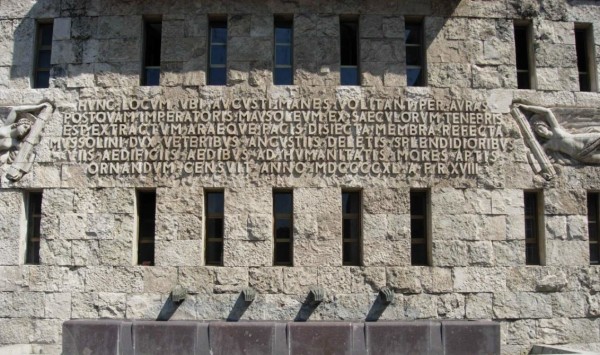 Mussolini’s name was defaced after the war. It’s in the 4th line down on the left hand side. Postwar Italy was eager to remove or deface all references to Il Duce. Year passed and a reverence for the architecture prevailed over the shame of the war years. The building is part of the Roman patrimony. The name and the facade was restored. HUNC LOCUM UBI AUGUSTI MANES VOLITANT PER AURAS POSTQUAM IMPERATORIS MAUSOLEUM EX SAECULORUM TENEBRIS EST EXTRACTUM ARAEQUE PACIS DISIECTA MEMBRA REFECTA MUSSOLINI DUX VETERIBUS ANGUSTIIS DELETIS SPLENDIDIORIBUS VIIS AEDIFICIIS AEDIBUS AD HUMANITATIS MORES APTIS ORNANDUM CENSUIT ANNO MDCCCCXL A F. R. XVIII Translation ( Walter Englert, Reed College ): This is the place where the soul of Augustus flies through the breeze after the Mausoleum of the Emperor was extracted from the darkness of the ages and scattered pieces of the Altar of Peace were restored. Mussolini, the leader, ordered the old narrow places to be destroyed and the location to be adorned with streets, buildings and shrines fitting for the ways of humanity in the year 1940, in the eighteenth year of the Fascist Era. 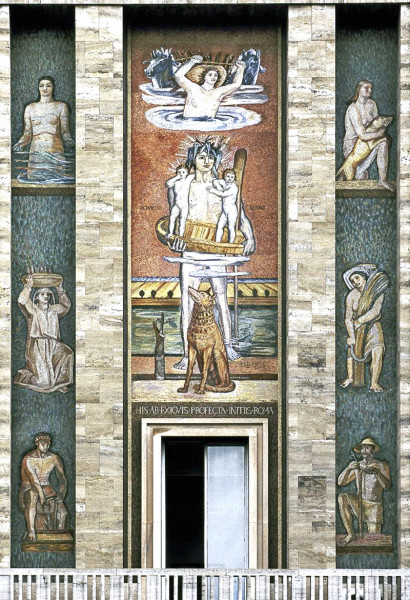 The center ceramic shows the ‘Birth of Rome’ with a young, strong figure (representing the Tiber River) standing in a river holding the two infants, Romulus and Remus. Below the figure is the she-wolf. On the sides of the ‘Birth of Rome’ are 6 figures representing the attributes of the people who made Rome a great Empire. Although the old Piazza Augusto Imperitore was mostly demolished, the Church of San Girolamo dei Croati (the national Catholic Church of Croatia in Rome) was spared. Mussolini relocated most of the parishioners from the Piazza when he demolished their buildings. In order to appease the Vatican, he agreed to build a monastery for the Church as part of the grand redesign. The Collegio degli Illirici monastery is still there and has some excellent examples of Fascist propaganda art. The Illirici are the people from Illyria, one of the ancient names for Croatia and the setting for Shakespeare’s Twelfth Night. FORO MUSSOLINI WAS RENAMED FORO ITALICO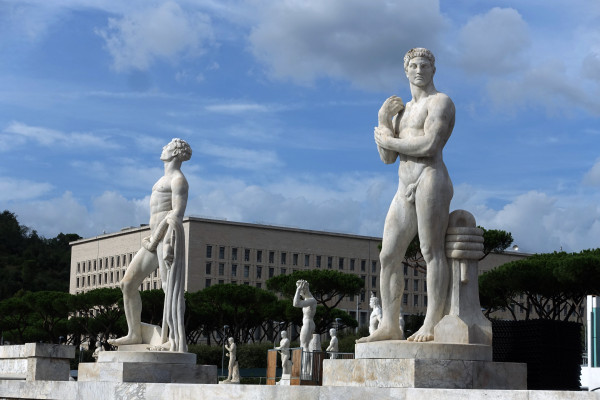 For the design and construction of the Forum he chose the 35 year old Enrico Del Debbio and the 30 year old Luigi Moretti . Their overall intention was to create a harmonious balance between the divine nature of the 16 th century Farnesina gardens of Pope Paul III with the power of Mussolini and modernist architecture. 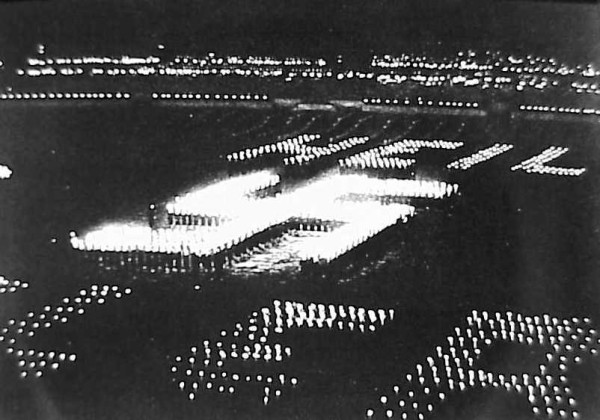 In 1938, Mussolini staged a grand spectacle in the Foro to welcome Adolf Hitler that included torch bearing Fascist youths forming a huge swastika. Hitler was impressed. Mussolini intended for the Forum to host the 1944 Summer Olympics but the games were awarded to London. Actually the 1944 games never happened. They were postponed until 1948.  Del Debbio completed the Academia della Farnesina (the Fascist academy of physical education) in 1928. The building is still painted the Pompeian red of the original design. It currently serves as the Italian Olympic Headquarters. 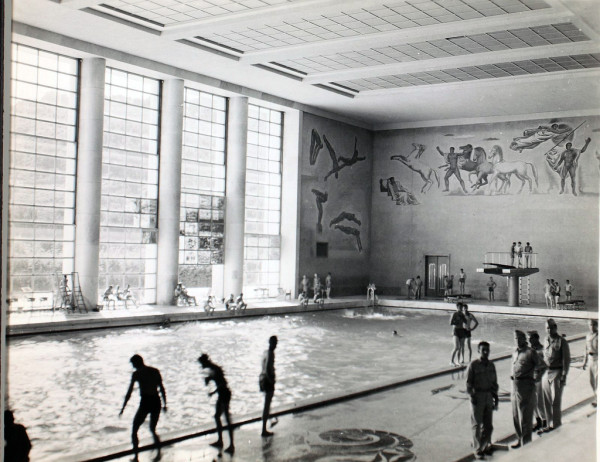 Balilla was the nickname of a Genovese boy named Giovane Battista Perasso, who threw a stone at some Austrian soldiers and started an Italian revolt against the Austrian Hapsburgs in 1746. Mussolini understood the future of the new Empire was in the hands of the glorified youth. Del Debbio completed the Stadio dei Cipressi in 1934 with a capacity of 50,000. 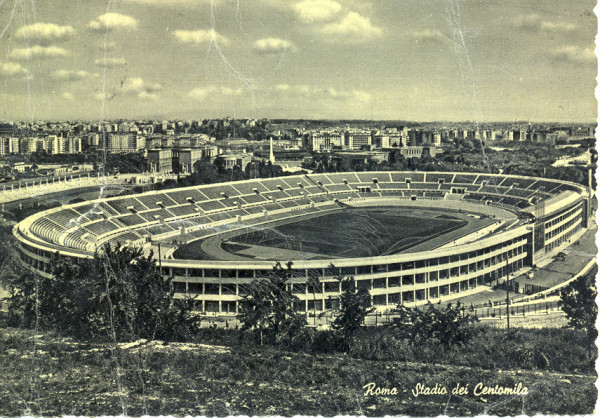 After the war the Stadio dei Cipressi was rebuilt as the Stadio Centomila , named for the 100,000 seating capacity, although the seating was reduced to 65,000 for the 1960 Olympic Games where Wilma Rudolf won 3 gold medals and Rafer Johnson won the Decathlon. 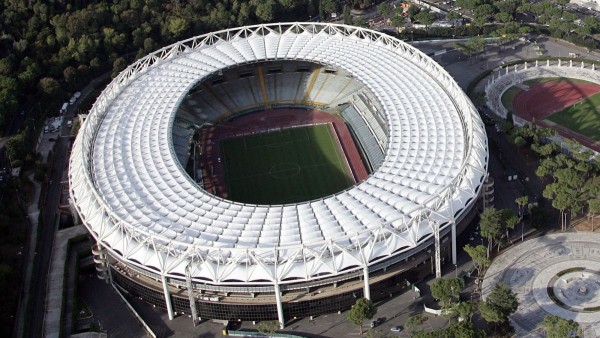 It became the Stadio Olimpico in 1974. In 1990 it went through a major overhaul. One of the architects of the 1990 design was Annibale Vitellozzi, one of the last remaining of the Rationalist Architects. He worked on the Stadium in the 1950’s getting it ready for the 1960 Olympics. Vitellozzi died in 1990. The Stadio Olimpico was his last project. The Olympic Stadium was updated again in 2008. It is currently the Stadium for the Roma and Lazio football clubs with a seating capacity of 70,261. 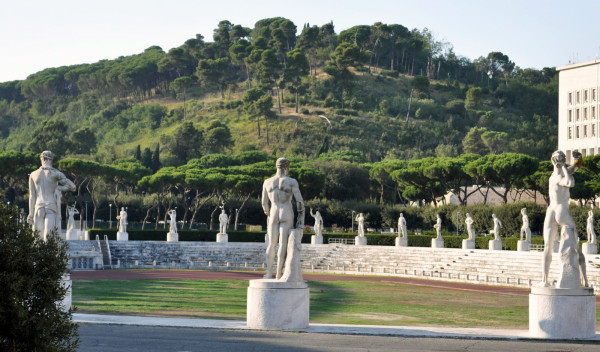 Del Debbio’s Stadio dei Marmi (Stadium of Marbles) was completed in 1928. The 5,200 seat track and field stadium is surrounded by life sized marble statues of athletes in classical pose. The original design had 64 statues. The Stadium opened with 60 of them. Now there are 59. No one knows what happened to the 60 th . The Stadium of Marble Statues is still used for track and field as well as Rugby matches and Equestrian competitions. It is still a powerful piece of architecture. 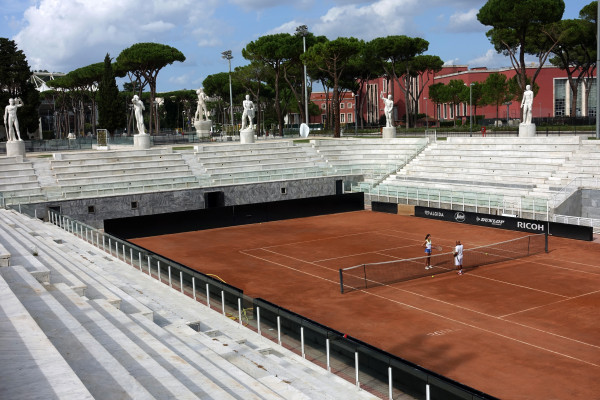 Del Debbio’s iconic marble statue ring was duplicated in the Campo di Tennis (1933-4) by Costantino Costantini. It has been the home of the Italian Open of Tennis since 1935. 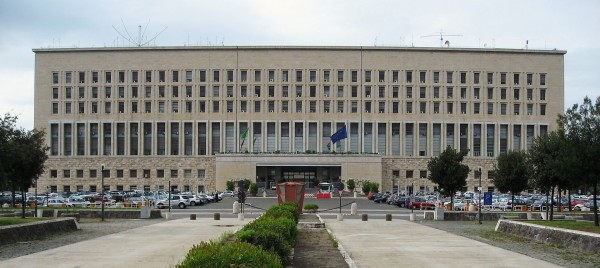 Del Debbio’s largest project for the Forum was the Palazzo della Farnesina. It was originally named the Palazzo Littorio (The Palace of the Lictors) for the ancient Roman Lictors, the personal bodyguards of magistrates and imperial administrators who carried the fasces, guarded imperial offices and carried out judicial justice handed down by the administrators. Designated to be the headquarters of the Fascist party, the Palazzo broke ground in 1935 but work was halted in 1943 when Mussolini was removed from power. It was (and still is) one of the largest buildings in all of Italy. Built around a central courtyard, it’s 169m long , 51 meters tall and 132 meters deep. It has 6.5 kilometers of corridors and over 1300 rooms. The project was so large it took Del Debbio, Vittorio Ballio Morpurgo, Arnaldo Foschini and Luigi Moretti and others to design it. Construction, along with the principal architects resumed in 1948 and was completed in 1959. It is currently the Ministry of Foreign Affairs of the Italian Republic . The completed Palazzo is very close to the original design. Aside from the Rational architecture of the building, the Palazzo also houses one of the best collections of 20 th century Italian Art, everything from Art Nouveau to Futurism, abstract, Arte Povera and avant-garde. In 1955, Rome was awarded the 1960 summer Olympics. The new Italian government invited the Rationalist Architects to finish their buildings in the now renamed Foro Italico. Del Debbio completed the Stadio del Nuoto , the Olympic swimming pool in 1959. He didn’t really work much after the 1960 Olympics and died in Rome in 1973. 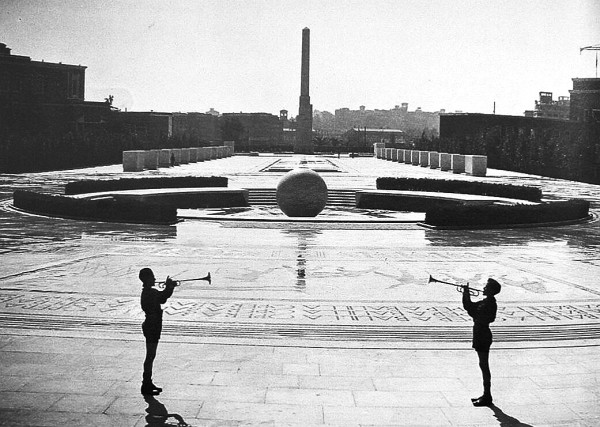 The 55’ tall Obelisk (by Costantino Costantini) is supported on base that more than doubles the size of the monument to close to 120’ tall. It is the largest single piece of marble ever quarried from Carrara. The top spire was rumored to be made of solid gold and on July 25th, 1943, the fall of the Fascist regime, people stormed the obelisk with tall ladders only to discover it was just gold paint. After the war, all public references to Il Duce were outlawed but to remove the letters of the obelisk would have greatly damaged the piece. Through some kind of nostalgia or architectural reasoning, the Mussolini Obelisk was saved, although it’s remained a sore subject. 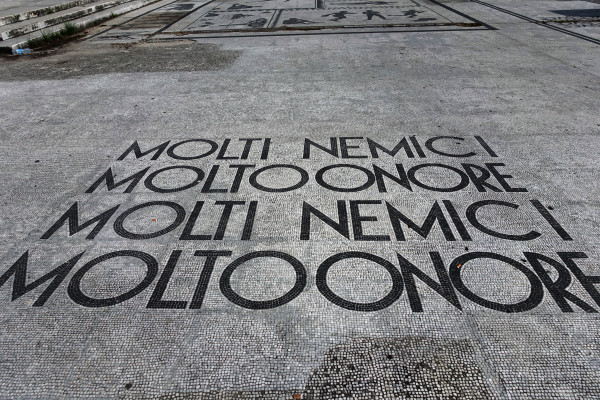 The Piazzale was once the site of blood pumping Fascist rallies. It’s a veritable ocean of mosaic propaganda. If you spend the time, you can count the 248 repetitions of the words IL DUCE or wander through the classical figures recreating mythological to modern heroic actions to clever Fascist propaganda sayings and symbols, all delightfully designed in black and white stone tesserae. The mosaic slogans range from many enemies, much honor , to Duce, we dedicate our youth to you , to better one day as a lion than 100 years as a sheep . More than 200 mosaic artists from Spilimbergo in Friuli created the over 10,000 square meters. The Mosaic School of Spilimbergo, created in 1922, is still one of the top mosaic schools in the country. The mosaic images have been destroyed and left to decay over the years. The Foro Italico is still the major sports complex of Rome. Yes, it is a bit embarrassing to greet all the foreign spectators with a couple of acres of Mussolini propaganda but there are currently no plans in place to either restore the Forum or replace it. In recent years a strapped for cash city proposed selling the Foro Italico to private investors. Protests sprung up from all over Italy. Mussolini’s legacy might be controversial but it belongs to Italy and the Italians want to keep it that way. 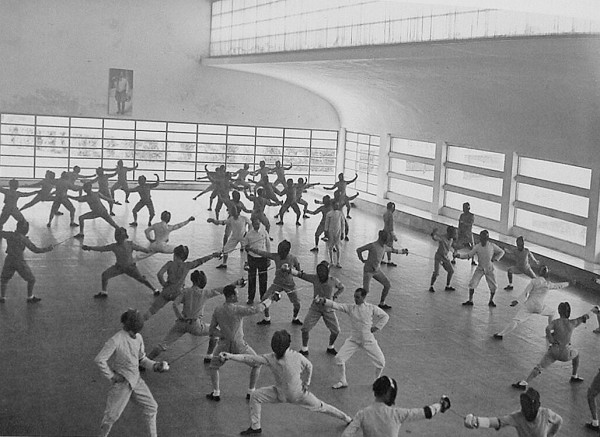 Moretti’s 1936 Academia di Scherma or Casa delle Armi was the fencing school. Swordplay was still popular in the 1930s. In 1981, the Casa delle Armi was appropriated by the Italian judicial arm of the government who turned it into a temporary police station and prison for the members of the Red Brigade, who most famously kidnapped and killed the Prime Minister, Aldo Moro in 1978. 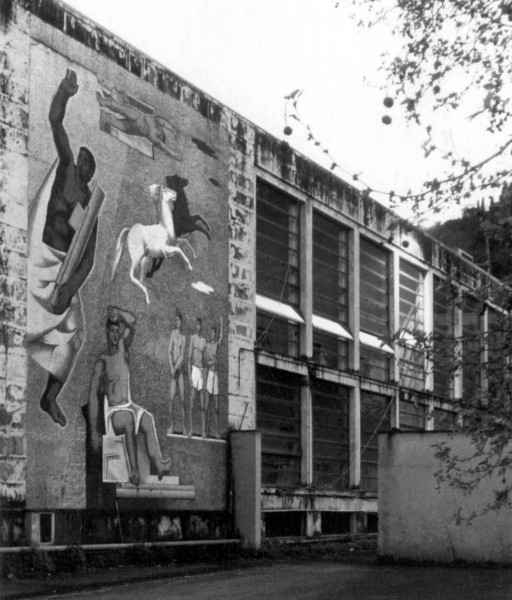 Ironically, Luigi Moretti has been architecturally associated with the downfalls of both Benito Mussolini and Richard Nixon. Luigi Moretti also designed the Watergate Complex where the Re-election committee of Richard Nixon broke into the Democratic national Headquarters in the Watergate complex. He died in 1973, a year after the Watergate break-in. Espozione Universale Roma , EUR, E42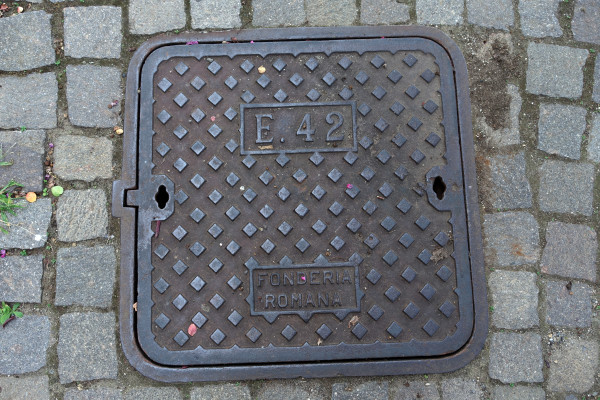 The most famous of the EUR buildings is the travertine marble Palazzo della Civilt à Italiana (1938-1943), more commonly known as the Colosseo Quadrato (the Square Coliseum) and less commonly known as Il Palazzo del Groviera (Swiss Cheese Palace). Taxi drivers will point to it and tell you it’s the symbol of Mussolini’s Fascism. Thoughts of human suffering and disapproval will most likely flood your imagination but if you look past the connection to Mussolini, you’ll see a remarkable building, a neoclassical nod to the ancient Coliseum packaged in a sleek futuristic, surreal design that looks like it jumped off the canvas of a Giorgio de Chirico painting. 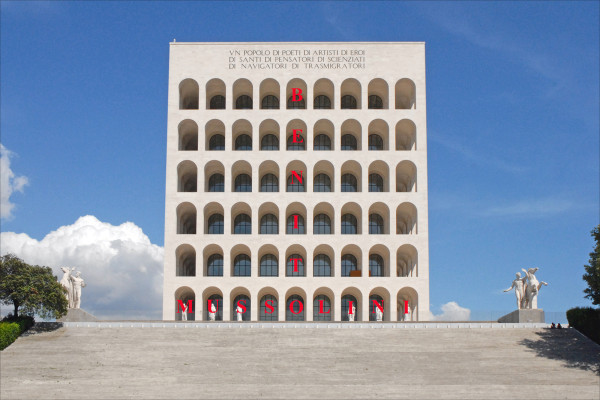 The architect in charge of the EUR fair was Marcello Piacentini , Mussolini’s High Commissioner of Urban Renewal. He kept a close hand on everything that went into EUR but he gave the Palazzo della Civilt à Italiana to three relatively unknown young architects named Giovanni Guerrini and Ernesto Lapadula and Mario Romano. The building was started in 1938 and finished in 1943. There is a lot of symbolism going on here. The obvious one is the futuristic take on the ancient Coliseum. The not so obvious is in the pattern of the arches. The 6 horizontal arches represent the 6 letters of the name Benito. The 9 vertical arches represent the name Mussolini. Over the entrance of each side is the inscription of dedication to the Italian people; poets, artists, heroes, saints, thinkers, scientists, navigators and transmigrators. 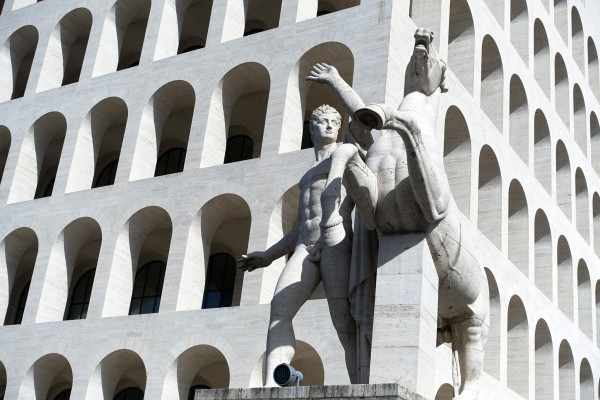 At the corners of the building base are 4 stylized versions of the Dioscuri, Castor and Pollux, the sons of Zeus and Leda the swan and the brothers of Helen of Troy. The Dioscuri were given credit for the victory of the Battle of Lake Regillus in 495 BC, where the Roman rebels defeated the allied forces of King Tarquinius Superbus (Tarquin the Proud) and officially began the Roman Republic. The Dioscuri have been watching over Rome for over 2,000 years. After 72 years of neglect and decay, the Palazzo della Civilt à Italiana / Colosseo Quadrato has been restored and refitted as the new world Headquarters for the Fendi fashion house. There will even be a 1200 square meter exhibition space of the 1st floor. Karl Lagerfeld, who’s been with Fendi for 50 years, says when he is in the building he feels like he’s being transported into the future, which is kind of ironic since the building was constructed around the same time he was born. 1942 would have been the 20th anniversary of the Fascists coming to power and Mussolini wanted to show the world what he had accomplished. However, Italy’s declaration of war on Britain and France in 1942 killed all international interest in the Fair. By 1943, Mussolini was on the run.  Piancentini awarded the entrance to the Fair to Adalberto Libera’s monumental 300m wide x 200m tall Arch. Although the Monumental Arch was never built in EUR, the concept did eventually come to life in 1965 when Eero Saarinen designed his now iconic 192m x 192m St Louis Arch. Adalberto Libera died in 1963. He never got to see the Saarinen arch. 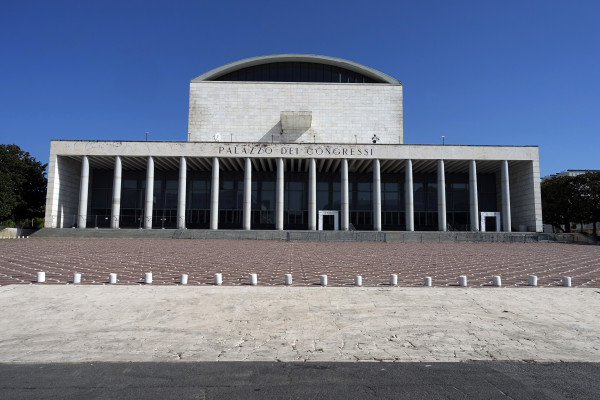 The Palazzo was completed in 1956 and used for the fencing competition of the 1960 Olympics.  The unfinished Palazzo served as an encampment for German troops in 1943 and an encampment for British troops in 1945. After the war it was used as a refuge shelter for displaced Romans, homeless from the bombings on the city. In 1977, three bombs exploded in the Palazzo in a fear tactic against the Convention/Congress of the Italian Socialist Party. The renovation that followed created a roof garden. It is still used for Political Conventions, Trade Shows and Corporate Conferences. Libera’s career flourished after the war. Most of the Rationalists were forced into membership in the Fascist party and consequently excused after the war. In 1958, Libera’s Hotel dei Congressi opened it’s doors in anticipation of the Olympic visitors. The hotel is still open if you want to have the experience of staying in a Rationalist style building. Libera also designed a number of houses, the most famous being the 1938 Casa Malaparte on Capri for the Italian writer, Curzio Malaparte. 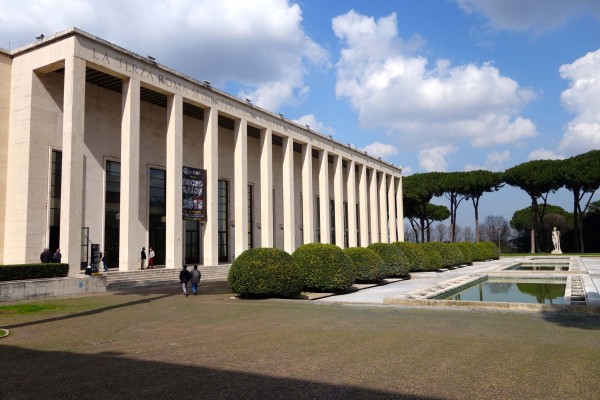 The Palazzo degli Uffici dell’Ente Autonomo was the first completed building of EUR. Designed by Gaetano Minnucci , it was finished in 1939. Originally built as an exposition Hall, it’s filled with black and white mosaics and reliefs drawn from the ancient Roman Empire. In one of the ancient reliefs, Mussolini sits on horseback in a mixture of modern kitch and classical. 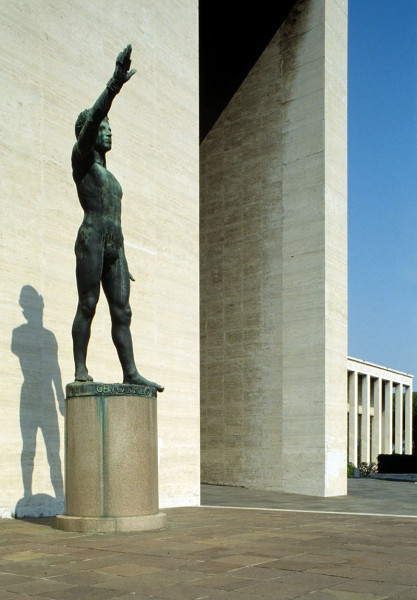 Close to the entrance is the sculpture of the Genio dello Sport (Genius of Sport), a bronze sculpture of a youth giving a Fascist salute to all who enter the building. The sculpture, created by the Florentine, Italo Griselli, was known as the ‘Saluto Fascista’ (the Fascist Salute) during the Fascist Era. It was renamed the Genio dello Sport after the war. The building housed offices for EUR and Fascist personnel. It was used by the German troops during the Nazi occupation in 1943 and by the British troops after the liberation of Rome in 1945. There was even a bomb shelter built under the building to hold 300 people.  The Museo della Civiltà Romana opened in 1955. It currently holds the fantastic scale model of 4th century Rome known as Il Plastico . Italo Gizmondi started the project in 1935. He finished it in1971 and died 3 years later. In another wing of the Museo della Civiltà Romana you can view the plaster cast copies of Trajan’s Column . It’s the only place where you can get a close and personal view of the story of Trajan’s defeat of the Dacians in the 2 wars of 101-2 AD and 105-6 AD. The museum also has reconstructed library that would have existed at Hadrian’s Villa at Tivoli. The Roman Civilization museum and a Planetarium are connected by a wide Roman style colonnade, a modernist version of an ancient roman aqueduct. The Museo della Civilt à Romana has been closed for repairs since January 2014. 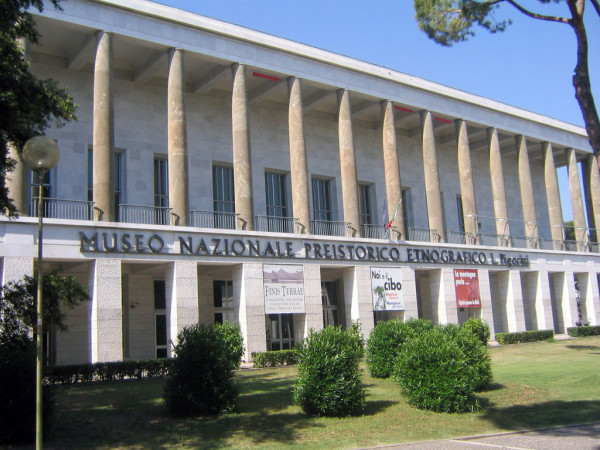 There are 92 marble panels along the sides of the monument depicting the important moments of the inventor’s life done in allegorical style. Dazzi began the project in 1937 but everything in EUR was abandoned in 1943. In 1952, he came back to the project but after too many interruptions, he smashed all the plaster models made for the giant stele and quit the job. It was his respect for the Marconi family that got him to return and finish the project in 1957. No matter how long you look at them, you’ll never be able to figure out what his life was all about. 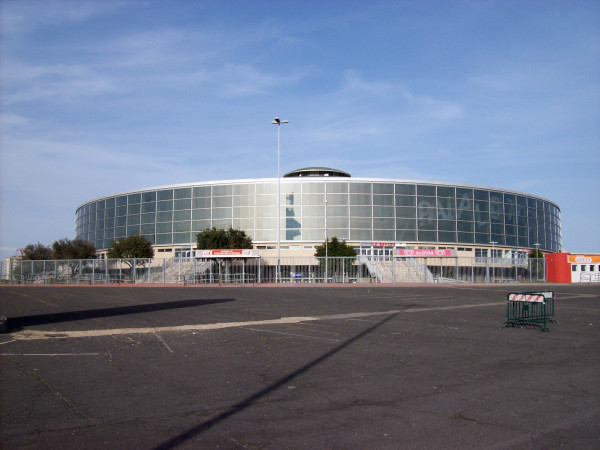 From the Marconi Obelisk, it is a straight shot to the Palazzo dello Sport , now called the PalaLottomatica, a large multipurpose sport and entertainment complex. Lottomattica, a large lottery company, paid for the remodeling between 1999-2003. The new stadium is called PalaLottomatica . It is the venue for stadium size International and Italian Rock tours. 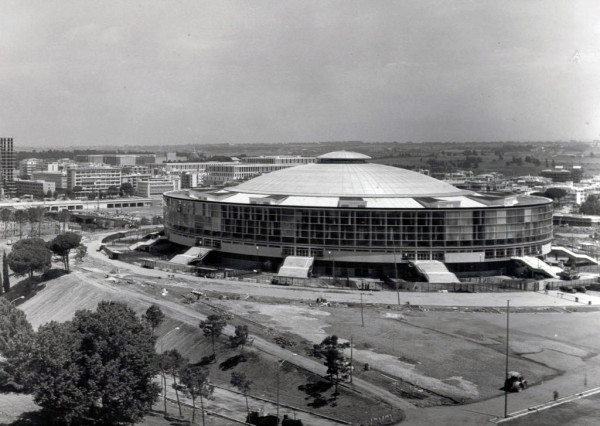 Marcello Piacentini , the main architect of Mussolini’s new Rome, never had problems finding work after the war. He was such a good architect, he got a big pass on his relationship with Mussolini. Along with the architectural engineer, Pier Luigi Nervi , Piancentini built the original flying saucer shape sports palace between 1958-1960. It hosted the 1960 Olympic basketball games. 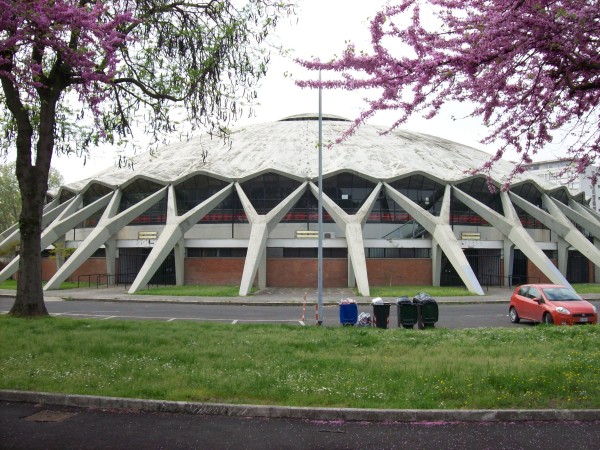 After the 1960 Olympics, EUR went through a building boom. Corporate offices and quick-built highrise apartment buildings crowded up against the Rationalist architecture of E42. Marcello Piancentini had proposed to use EUR as a business park after the E42 expo but in the 1960s had no design oversight. The design by committee city planning that has plagued Italy since the end of the war created a hodgepodge of brutal 60s and 70s architecture. EUR became a suburb of Rome filled with thousands of people. The Metro B line will let you off at 2 different stops (EUR Palasport and EUR Fermi) where you can easily walk through the EUR complex.  As of 2015, Rome has stepped up to curb the prostitution in EUR, designating certain areas a Prostitute free zones. They are adding more police surveillance and handing out out fines up to €500 if caught having sex with a sex worker in a prostitute free zone. EUR is changing. Most of the 1970s building are coming down and new modern steel and glass office building are going up.Hopefully the new plan of EUR will integrate the Rationalist architecture into the modern business park. As much as the Italians try to ignore the legacy of Mussolini, he will be with them forever. Rome is a city that lives with it’s past but change comes very hard. It take a long time to get anything done. The closure of the Via dei Fori Imperiali to pedestrian traffic has caused major outcries among the Romans and the new Metro C being built under the road could take 8 years before the station opens. The MAXXI (Museum of Arts of the XXI century) by Iraqi-British architect, Zaha Hadid took 11 years to complete. It was built in the Flaminia neighborhood, close to the Foro Italico. The 5,000 square meter Holocaust Museum in Rome has been in the planning stage for over 10 years. The Luca Zevi and Giorgio Tamburini design was destined to be built next to the Villa Torlonia, the former residence of Benito Mussolini. It would be the second largest Holocaust Museum in Europe. I pointed out some of the main pieces of Mussolini’s architectural legacy in Rome but there are other buildings that didn’t make it into this piece. At Villa Torlonia, you can visit the World War II bunkers created for Mussolini and his family. The Enrico Del Debbio Foresteria Sud , a guest quarters built at Foro Mussolini is now used as a Youth Hostel. The Foresteria Nord by Costantino Constantini, another guest quarters at the Foro is now used as part of the Scuola Nazionale dell’Amministrazione. Marcello Piancentini along with other architects of the Rational Movement designed and built the new campus of La Sapienza University near the Termini train station. La Sapienza is also known as the University of Rome. Arnaldo Foschini led a group of Rationalists in the construction of the Church of Saints Peter and Paul in EUR. Adalberto Libera designed the Post office on Via Mamorata, near the Pyramid of Cestius and the Porta di San Paolo. It’s a short walk from the Roberto Narducci Ostiense train station. Luigi Moretti designed the Casa della Gioventù on the Via di Porta Portese in Trastevere. It’s across the Ponte Sublicio. Mussolini’s 1936 Building for the Department of East Africa (Somaliland, Eritrea and Ethiopia), across the street from the Circus Maximus is now the Food and Agriculture Organization of the United Nations (FAO). 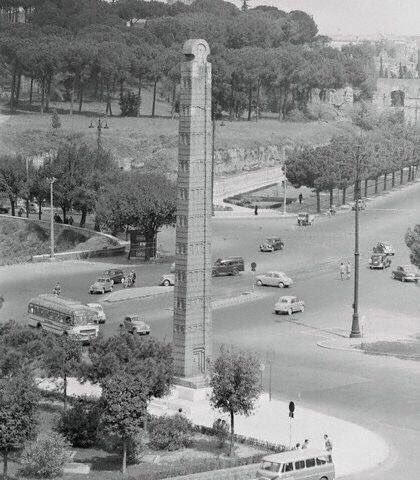 The Obelisk of Axum, a 24meter tall, 1700 year old granite obelisk stolen from Ethiopia was a war prize sat in front of the building until 2005 when it was repatriated back to Ethiopia. But this is another story. Share this:You may also like:
You must be logged in to post a comment.
The Cornell Lab of Ornithology builds the eBird global platform for communities and partners around the world to advance data-driven science, education, and conservation. Checklist S187967982Sharing links, additional details, share this checklist with other participants' ebird accounts.. Manage My Contacts Are you submitting a complete checklist of the birds you were able to identify? Yes Learn More
Checklist CommentsObservations, canada goose, rock pigeon (feral pigeon), chimney swift, laughing gull, great egret, black vulture, turkey vulture, cooper's hawk, eastern kingbird, barn swallow, carolina wren, house sparrow, american goldfinch, exotic species. Exotic species flags differentiate locally introduced species from native species. Naturalized : Exotic population is self-sustaining, breeding in the wild, persisting for many years, and not maintained through ongoing releases (including vagrants from Naturalized populations). These count in official eBird totals and, where applicable, have been accepted by regional bird records committee(s). Provisional : Either: 1) member of exotic population that is breeding in the wild, self-propagating, and has persisted for multiple years, but not yet Naturalized; 2) rarity of uncertain provenance, with natural vagrancy or captive provenance both considered plausible. When applicable, eBird generally defers to bird records committees for records formally considered to be of "uncertain provenance". Provisional species count in official eBird totals. Escapee : Exotic species known or suspected to be escaped or released, including those that have bred but don't yet fulfill the criteria for Provisional. Escapee exotics do not count in official eBird totals. Public information for Sensitive Species is restricted due to potential harmful impact to these birds. Site-specific information is visible only to the observer and eBird reviewer(s) for the region. We encourage you not to share specific location information about this sighting via social media, public websites, or email listservs. Learn more about Sensitive Species in eBird. Change portalIf you click "Change Portal", this checklist will be assigned to the portal you select below. This will allow you to switch to a portal-specific protocol if desired. Hide this ChecklistHiding a checklist will exclude the taxa on it from all forms of eBird output that show a location (including bar charts, maps, and arrival/departure tables), but the observation will still be accessible to you, and will appear on your lists. It will be considered not public in the eBird database since we cannot approve bird records without accurate location information. Although we understand that some checklists need to be excluded from eBird's public output due to privacy concerns or other issues, we strongly recommend against this unless absolutely necessary. Are you sure you want to hide these observations? Submit another for...Seaford Boat Ramp and No Name RD, Sussex County, Delaware, US on Sat Jul 20, 2024 Seaford Boat Ramp and No Name RD, Sussex County, Delaware, US Another location near Seaford Boat Ramp and No Name RD, Sussex County, Delaware, US on Sat Jul 20, 2024 Another location near Seaford Boat Ramp and No Name RD, Sussex County, Delaware, US Sat Jul 20, 2024
What was the name of Mussolini's Yacht in World War II?
Related triviaHow many names did the first telephone book have in 1878.
 Young Edgar Degas made over 700 copies of what?
You can get a fabulous view of what city from Mount Victoria?
You can find Grand Teton National Park in which U.S. state?
With which fellow painter did Salvador Dali become friends while in Paris?
With what type of quick drawings did a young Claude Monet begin creating art?
With what Russian spacecraft did the space shuttle Atlantis dock in 1995?Add question to a list. Added to list  |
IMAGES
VIDEO
COMMENTS
The yacht was a gift to the Fascist dictator in the 1930s. Italian police have seized a yacht that once belonged to Italian dictator Benito Mussolini from a businessman they believe has links to organised crime. The historic sailboat, called Fiamma Nera (Black Flame), was one of nearly €30m in assets taken from Italian entrepreneur Salvatore ...
Attempts to restore the Republic after Caligula's death failed. The Roman military ignored the senate and reinstated Imperial monarchy. Caligula's floating palaces, too, went the way of their creator. Their hulls pierced, the immense ships were weighted with stones and sunk to the lake bottom. Pride and the Fall.
Origins Regia Marina naval jack until 1900. The Regia Marina was established on 17 March 1861 following the proclamation of the formation of the Kingdom of Italy.Just as the Kingdom was a unification of various states in the Italian peninsula, so the Regia Marina was formed from the navies of those states, though the main constituents were the navies of the former kingdoms of Sardinia and Naples.
We would like to show you a description here but the site won't allow us.
Italian police said on Monday they had seized a yacht that once belonged to Fascist dictator Benito Mussolini from a businessman possibly linked to a huge organized crime network.
In the 1920s, under orders from Mussolini, the lake was drained and the ships were dug out from the mud. Soon after being uncovered, however, the two ships were destroyed in World War II.
Italian police said on Monday they had seized a yacht that once belonged to Fascist dictator Benito Mussolini from a businessman possibly linked to a huge organized crime network. A confiscation ...
Italian police have seized a yacht that once belonged to Fascist dictator Benito Mussolini from a businessman suspected to be linked to organised crime. The yacht was among €28 million ($47 ...
Please take note that the caption of the first photo of this page (published also on page 228 of "Mussolini's Navy") is mistaken. In fact, it was taken in June 1942 as stated in the original caption: "Taranto, 21 June 1942. Aboard the battleship Littorio, Mussolini reviewing the ship's crew, followed - from
Benito Mussolini. Benito Amilcare Andrea Mussolini [a] (29 July 1883 - 28 April 1945) was an Italian dictator who founded and led the National Fascist Party (PNF). He was Prime Minister of Italy from the March on Rome in 1922, until his deposition in 1943, as well as Duce of Italian fascism from the establishment of the Italian Fasces of ...
Italian police seize a yacht once belonging to Italy's fascist dictator Benito Mussolini from a businessman suspected of organized crime links. The sailboat,...
The Fascist government of Benito Mussolini worked to recover Caligula's ships for about five years - from October 1928 to October 1932. Mussolini ordered antiquarian Guido Ucelli, the Italian Navy, engineers of Civil Engineers, industry, private individuals, and archaeologists to drain Lake Nemi. The local people and archaeologists knew of ...
Clearly, he takes his yacht out for a spin on the Tyrrhenian Sea. Italian strongman Benito Mussolini used that yacht—the Fiamma Nera or "Black Fire"—for aquatic romps with his hot mistress Clara Petacci, but scuttled the boat in 1943 after Italy's World War II fortunes turned for the worse.
The remains of the hull of one of the two ships recovered from Lake Nemi.Workers in the foreground give an indication of scale. 1930 The remains of a Lake Nemi ship in 1929. The Nemi ships were two ships, of different sizes, built under the reign of the Roman emperor Caligula in the 1st century AD on Lake Nemi.Although the purpose of the ships is speculated upon, the larger ship was an ...
Ciano was killed in 1944 and Mussolini and his mistress then took the boat, which bears the formal name of Chryseis. After Mussolini was executed in 1945, Italian rebels used the boat to smuggle arms.
In 1928, Benito Mussolini ordered the whole of Lake Nemi to be drained so that the ships could be recovered. Engineers reactivated an ancient Roman underground water conduit linking the lake to farms outside the crater and began pumping water. Five months later, the first ship broke the surface. Two years later, the second ship was exposed.
Salnik's truck and trailer were found at the boat launch. His phone was going straight to voicemail. At 6:22 a.m. Monday, the capsized 18-foot Gulf Coast Sailboat was found just south of ...
More options ...
The company added a boat called the "William Richard" to its fleet in 2020.. Dan Musser, the former owner of the Grand Hotel on Mackinac Island and the current chair of Arnold Freight Company ...
A bloodied Donald J. Trump made Secret Service agents wait while he expressed his defiance. The moment epitomized his visceral connection with his supporters, and his mastery of the modern media age.
Mussolini allied with German dictator Adolf Hitler in World War II, and ruled Italy until 1943 when he was voted out of power by his own Grand Council and arrested. After German commandos rescued ...
Mussolini's archeologists excavated much of the ancient seaport between 1938 and 1941, hoping to get the ancient site ready for the failed 1942 Esposizione Universale Rome (EUR). More than 600,000 cubic meters of earth (up to 12 meters in depth) was removed to reveal the ancient street level.
Funny Boat Names: Have a Giggle Creating Puns. A pun or light-hearted name will amuse passers by and brighten up their day. Boating is an outlet, a release from the demands of life and a name that reflects the joy that your boat brings is something that should be embraced. A banterous name like "Aquaholic" will add a lighthearted vibe to ...
Seaford Boat Ramp and No Name RD, Sussex County, Delaware, US. Same area and date Another location near Seaford Boat Ramp and No Name RD, Sussex County, Delaware, US on Sat Jul 20, 2024. Same area Another location near Seaford Boat Ramp and No Name RD, Sussex County, Delaware, US. Same date Sat Jul 20, 2024. Different location and date
Alessandra Mussolini (born 30 December 1962) is an Italian politician, television personality, ... She has since campaigned for Italian law to be changed to allow all children to take their mother's last name if they wish. Her husband was one of the accused scheduled to appear in court for a child prostitution trial in 2015. In 2013, around 50 ...
What was the name of Mussolini's Yacht in World War II? General, History, World; Aurora; Show answer. Russel Brown. 64 72 Related trivia. How many names did the first telephone book have in 1878? Funny, History; 50; Show answer.